Edwin J Thomas Performing Arts Hall Architecture Design Brutalism
The 100 Best Buildings in Boston
Behold the city'due south architectural treasures — according to us.
Edited by Madeline Bilis, with Ellen Gerst, Simone Migliori, and Jules Struck

B
rutalism. Beaux Arts. Victorian. Colonial Revival. Boston isn't lacking in the interesting-looking building section. While there are loads of old structures—and tons of new ones springing up—non all of them are, you know, good . For that reason, and the fact that the city isn't known for its dazzling architecture , we've compiled a listing of the 100 best buildings here.
The ranking, of class, is wholly subjective and highly opinionated. Nosotros honey Brutalism, and then what? And aye, there are quite a few old white male person architects represented. This is Boston, after all. But we hope everyone will exist able to spot a few of their personal favorites in here, from iconic designs, to well-known architects, to neighborhood landmarks, and more.
We ranked the buildings—with a few choices in Cambridge, for good mensurate—with several factors in heed, such as architectural prestige, design, historical significance, and plain former coolness.
Wait over our list and tell us what you think. Arguing is encouraged.

Photo past Eric Clark
100. Massachusetts Historical Society Building
1154 Boylston St., Boston
Year completed: 1899
Builder: Edmund March Wheelwright
Information technology's just plumbing equipment that the oldest historical social club in the United states of america would have a nearly 120-year-old domicile. The Massachusetts Historical Society, founded in 1791, had its headquarters modeled in the Colonial Revival style. The bow forepart exterior, Doric columns, and done-out color of its yellow Roman brick gives this historical structure in the Fenway stately curb appeal.

Photograph by Eric Clark
99. B oston Burn Section, Engine 22
700 Tremont St., Boston
Year completed: 1960
Builder: Unknown
The low-slung, overhanging roof and midcentury modern way of this burn station makes it a conspicuous characteristic on Tremont Street, well-nigh the South Finish branch of the Boston Public Library. 2 plaques installed on the outside of the station commemorate the lives of five soldiers who died in the line of duty during the 1972 Vendome Hotel Fire.
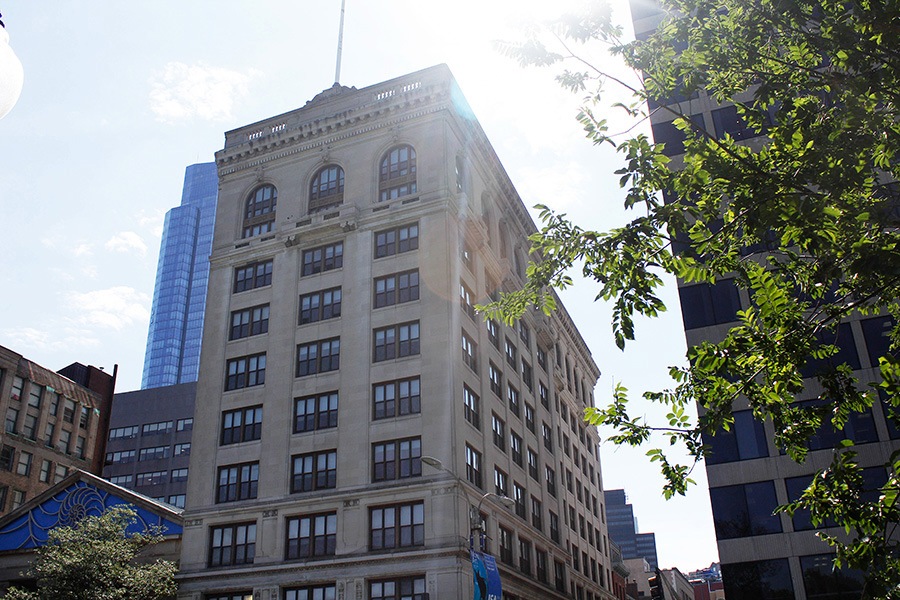
Photo by Simone Migliori
98. R.H. Stearns Building
140 Tremont St., Boston
Year Completed: 1909
Architect: Parker, Thomas & Rice
Alpine and neat, the Beaux Arts-style R. H. Stearns building hints at a bustling interior full of role dwellers poring over spreadsheets. In fact, it used to exist a department store and offices, though these days it serves the purpose of housing for the elderly.

Photograph by Eric Clark
97. Simmons Hall
229 Vassar St., Cambridge
Twelvemonth Completed: 2002
Architect: Steven Holl Architects
MIT's Simmons Hall is a Cubist's dream. The huge geometric masterpiece comes to life at night with the steady blinking of some 5,500 windows, almost similar a huge computer modem. The architect's idea was to create more of a living, breathing structure, however. He wanted a porous design to allow for light filtration all throughout the mammoth structure.
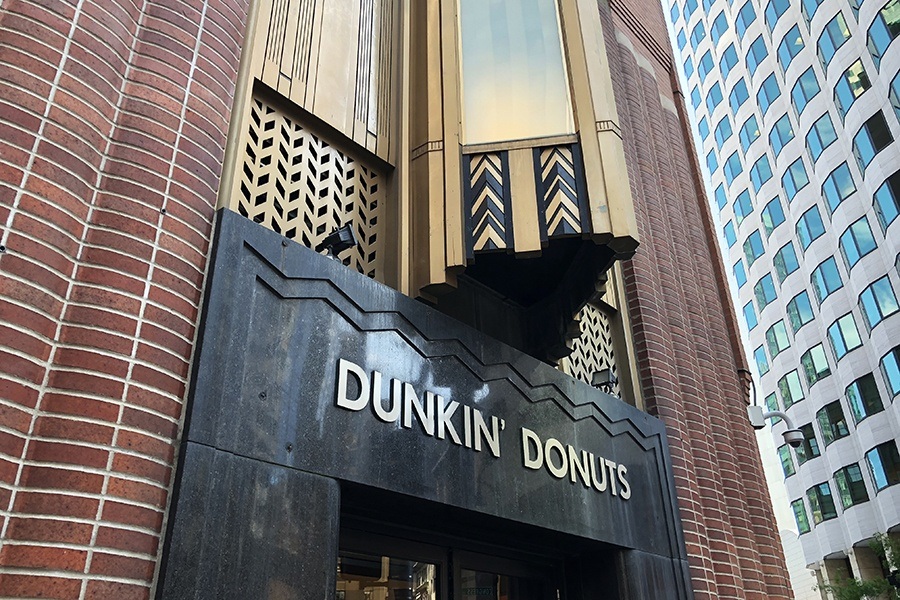
Photo by Madeline Bilis
96. Art Deco Dunkin' Donuts
230 Congress St., Boston
Twelvemonth Completed: 1930
Architect: Stone & Webster Applied science Co.
Built as a Western Union outpost in 1930, this Art Deco construction is at present home to a très fancy Dunkin' Donuts with polished marble and geometric ornamentation. (This Dunkin's is so expert, information technology's worthy of alove letter .) Its exterior takes blueprint cues from Egyptian and Mayan fine art, Cubism, Fauvism, and Expressionism. Just look at that chevron motif.
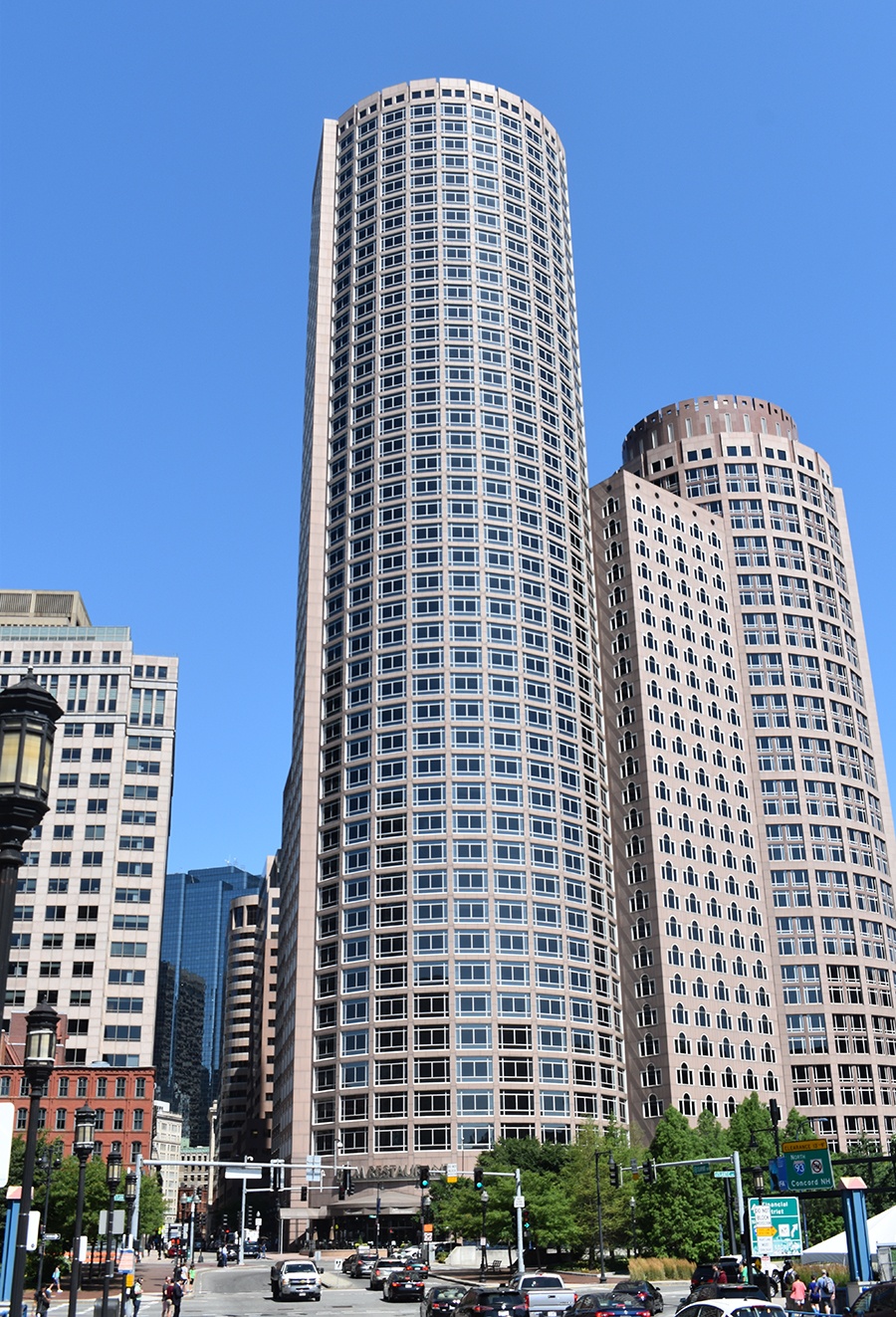
Photo by Jules Struck
95. Ane International Place
100 Oliver St., Boston
Year completed: 1987
Architect: Johnson/Burgee Architects
Famous from beingness etched onto hundreds of mugs, t-shirts, and art prints of the Boston skyline, One International Identify (all 46 floors of it) towers over the Fiscal District. Its rounded modern facade means more than windowed offices inside and an impressive cervix-stretching acme on the exterior.
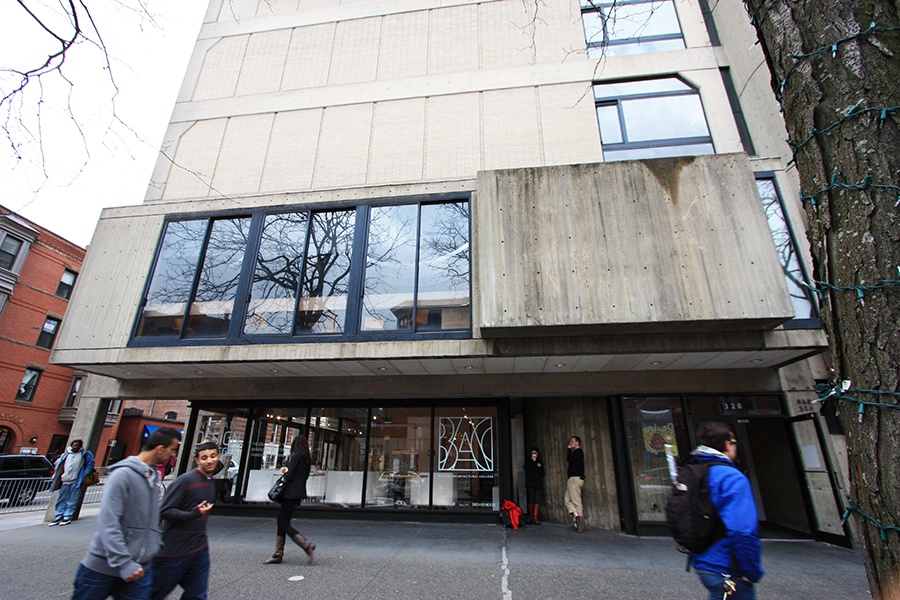
Photo via Wikimedia/Artistic Commons
94. Boston Architectural College
320 Newbury St., Boston
Year completed: 1966
Builder: Ashley, Myer & Associates
Although its backside resembles a classical edifice topped with a dome, the Boston Architectural College really lives within a concrete-and-glass structure. The domed advent actually comes from a deceptively detailed mural that was added near 10 years afterward construction. Its Newbury Street side, yet, is rectangular, big-windowed, and a welcome Brutalist interruption in Dorsum Bay.
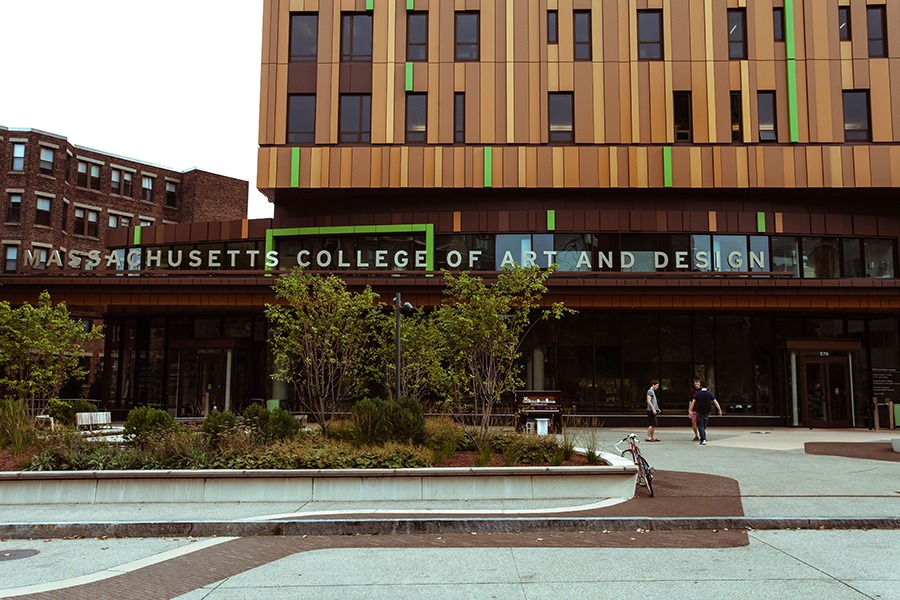
Photo by Alex Lau
93. MassArt Treehouse
578 Huntington Ave., Boston
Year completed: 2012
Architect: ADD Inc.
For a primarily commuter college, building a residential hall marked a menses of major growth at Massachusetts College of Fine art and Pattern. Its Treehouse residence hall appropriately fuses growth and fine art into i structure. Inspired by Gustav Klimt'due south Tree of Life, the building's exterior boasts a comparable mosaic design out of staggered aluminum panels. A dark-colored base gradually lightens toward the top into the same shade of tan Klimt used on the bark of his tree. "I find the blueprint then optimistic, colorful, and refreshing," says the blueprint team's leader, Tamara Roy .
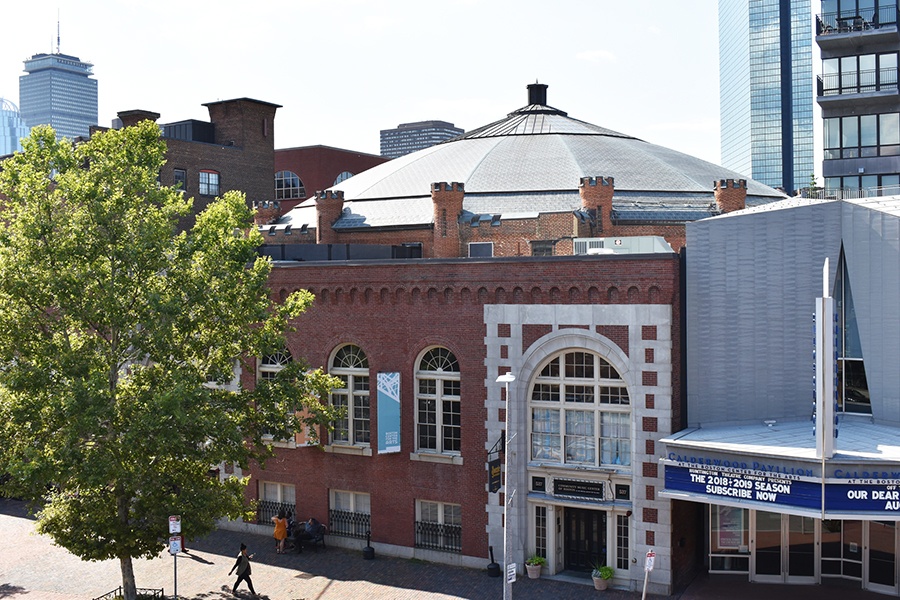
Photo past Jules Struck
92. The Cyclorama at Boston Centre for the Arts
539 Tremont St., Boston
Year Completed: 1884
Architect: Charles Cummings, Willard Sears
The S Terminate's rounded Cyclorama was built to house a 400-pes round painting of The Battle of Gettysburg , but the Classical Revival-Victorian outside shouldn't be overlooked. Its pleasingly symmetrical dome is bordered by high turrets and sports classically beautiful brick work.
91. Madison Park High Schoolhouse
75 Malcolm X Blvd., Roxbury
Year completed: 1977
Architect: Marcel Breuer and Tician Papachristou
It's the only Marcel Breuer-designed edifice in metropolis limits, and it's severely underappreciated. Madison Park High School is a series of physical-faced structures that, like Urban center Hall, resemble honeycombs. "The interconnected buildings house some of the most outstanding facilities of any loftier school in the state," write Susan and Michael Southworth in their 1984 AIA Guide to Boston . The gymnasium alone contains three pools and a rowing tank.

Photo by Simone Migliori
90. Sometime South Meeting Business firm
310 Washington St., Boston
Year completed: 1729
Architect: Robert Twelves
If the founding fathers returned to Boston today, they wouldn't recognize most of it. Only they could notwithstanding probably find their bearings based on the Old Southward Meeting House's iconic white steeple. Famously the site where the Boston Tea Political party was organized, it at present sits amid the shiny new part buildings and 7-Elevens of Downtown Crossing, just the red brick and light-green oxidized copper ensure information technology holds its own.

Photograph by Margaret Burdge
89. New England Aquarium
1 Central Wharf, Boston
Year completed: 1969
Architect: Cambridge Seven Assembly
The New England Aquarium is wonderfully Brutalist both inside and out, which makes sense, since the building was designed from the inside out. Dreamed up by aquarium specialist Peter Chermayeff, a founding partner of Cambridge Seven Assembly, the concrete structure was built around a i-manner visitor path that makes its way through a dark atrium infinite. According to Peter Chermayeff LLC, the visitor experience switches between big and minor, dark and lite, and moisture and dry, and is anchored by a primal cylindrical tank.
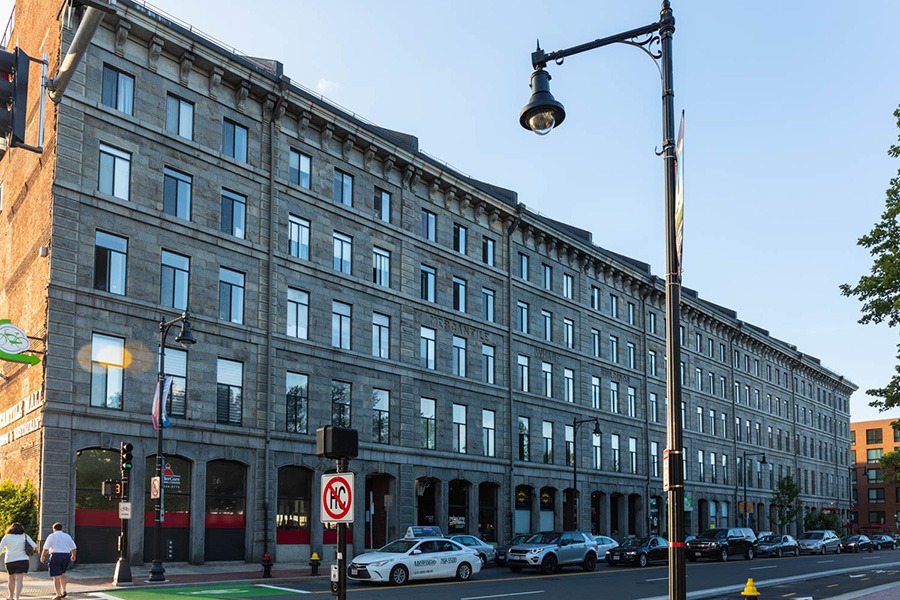
Photo by Eric Clark
88. Mercantile Wharf Building
33-81 Mercantile St., Boston
Year completed: 1856
Architect: Gridley James Fox Bryant
Back when Quincy Market used to border the Boston waterfront, the Mercantile Wharf building served equally a storage warehouse, which explains its rough Boston granite exterior and imposing length and width. A cornice trims the length of the building on top, while the bottom level traces a series of arched entrances in groups of three. After a fire ripped up the interior of the building in the '70s, the bottom level was converted into neighborhood businesses, the upper floors into apartment units.

Photo by Simone Migliori
87. Ames Building
1 Court St., Boston
Yr completed: 1889
Architect: Shepley, Ryan, and Coolidge
One of Boston'southward earliest skyscrapers doesn't seem so tall anymore, only its Romanesque way has stood the test of time. The closer you look, the more ornate details yous can spot, from the carved doorways to the extremely detailed overhang all the fashion at the tippity top.
86. The Liberty Hotel
215 Charles St., Boston
Twelvemonth Completed: 1851
Builder: Gridley James Fox Bryant
This posh hotel used to exist the Charles Street Jail until 1990 when it was closed due to overcrowding. The beautiful building is all swank and luxury now, though the hard symmetry of the exterior still manages to remind us of something more than custodial than ostentatious.
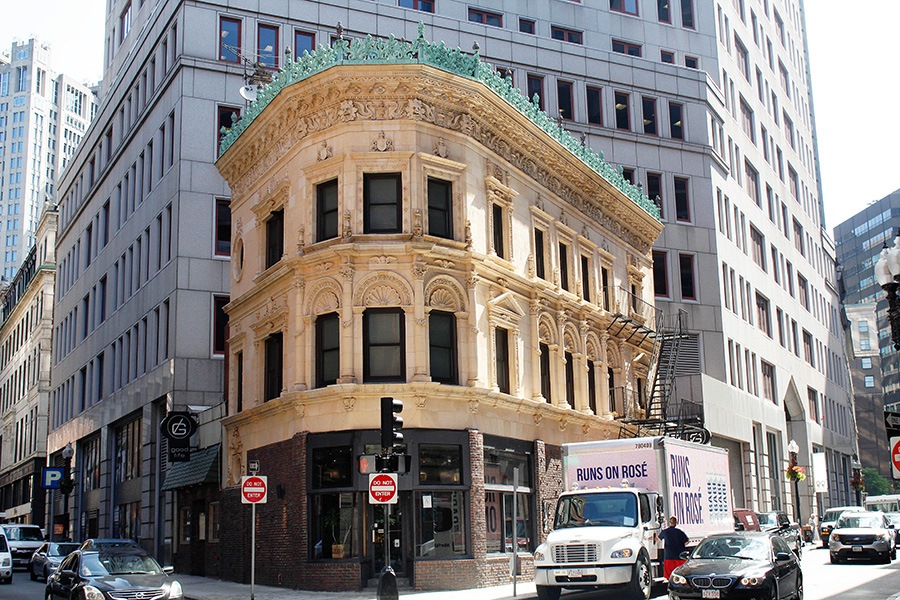
Photograph by Simone Migliori
85. Proctor Edifice
100-106 Bedford St., Boston
Year Completed: 1897
Architect: Winslow and Wetherell
The stout and regal Proctor Edifice wears its oxidized copper cornice similar a crown. It is an fine art piece from the 1890s that has remained an uncommon ode to the Spanish Renaissance way equally newer, taller buildings crop upwardly around it.
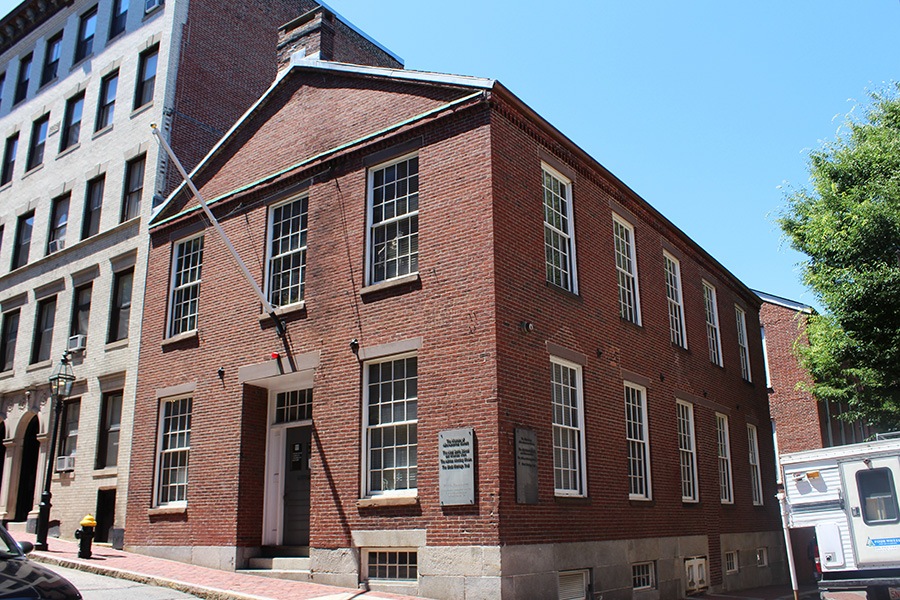
Photograph by Ellen Gerst
84. Abiel Smith School
46 Joy St., Boston
Year completed: 1835
Architect: Richard Upjohn
The Abiel Smith School, located in a brick schoolhouse in Beacon Hill, was the first publicly funded school for African American children in the U.S. The traditional structure became the site of Boston'south fight for educational equality, and information technology wasn't until 1855 that the American flag hanging from the protruding pole on the school's facade stood for the kids inside, too.
83. Longfellow Business firm
105 Brattle St., Cambridge
Twelvemonth completed: 1759
Architect: Major John Vassall
This quaint Georgian mansion near Harvard Square was utilized past George Washington as a headquarters during the Siege of Boston, and later, poet Henry Wadsworth Longfellow called the mansion home for most of his life. The pastel-colored abode is just constructed with two-story columns and a center pediment, creating a gorgeous contrast with the lush lawns that surround it.

Photo by Simone Migliori
82. Batterymarch Edifice
54-66 Batterymarch St., Boston
Year Completed: 1928
Architect: Harold Field Kellogg
The Batterymarch Building went up in 1928, and though it no longer towers over its neighbors, this rosy skyscraper is still a striking example of Fine art Deco flair.

Photograph via Wikimedia/Creative Commons
81. Winthrop Building
276-278 Washington St., Boston
Year completed: 1893
Architect: Clarence H. Blackall
For Boston's first wholly steel-framed structure, the Winthrop is surprisingly vintage in appearance. Its egg-and-tongue molding, Renaissance Revival style, and dark greenish and ruby brick facade stand out adjacent to the cool grey granite of its neighbors. The Winthrop was originally dubbed the Carter Edifice, merely was afterward renamed later on Governor John Winthrop because he in one case owned a domicile right next to information technology.
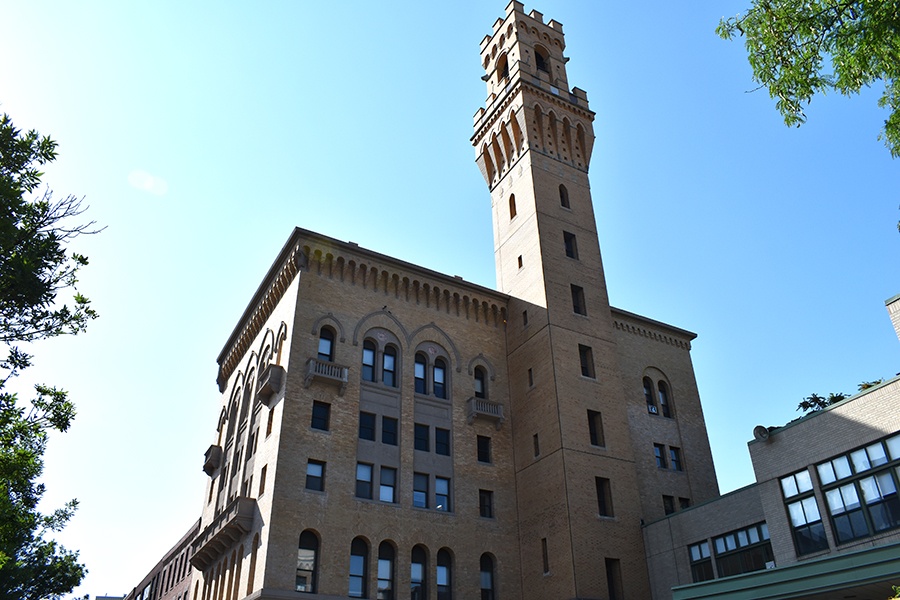
Photo by Jules Struck
eighty. Pine Street Inn
444 Harrison Ave., Boston
Year completed: 1894
Builder: Edmund March Wheelwright
Created in the fortress style of Florence's Palazzo Vecchio (and appearing strikingly like to Provincetown's Pilgrim Monument ), the Pine Street Inn originated as a headquarters for the Boston Burn down Department. The firefighters' need for a picket tower explains how the architects managed to skirt the old 125-human foot height limit for Boston buildings. The tower itself, which dominates the structure, is made upward of xanthous brick, evoking the image of a medieval battlement. Past 1969, the building had changed its apply dramatically. Now, it is owned and operated by the Pine Street Inn, a homeless shelter and social services eye.
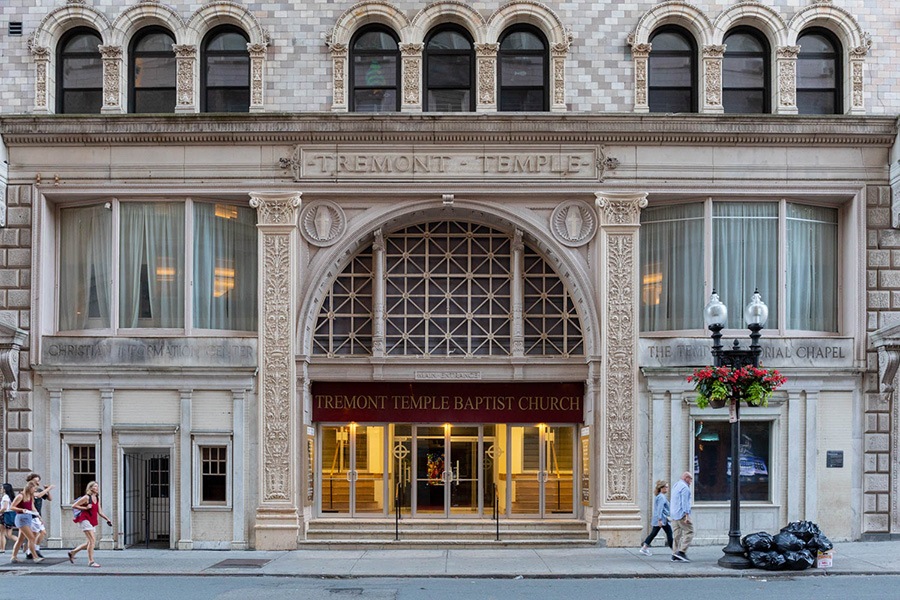
Photo by Eric Clark
79. Tremont Temple
76 Tremont St., Boston
Twelvemonth completed: 1896
Builder: Clarence H. Blackall
Continuing curbside and peering upwards at the flat face of the Tremont temple has a dizzying upshot, a event of its enormity and the Venetian-style diamond-patterned stonework. In the belatedly 1800s, the Gratuitous Church Baptists of Boston needed an improved space for their free and attainable congregations—and prolific architect Clarence Blackall delivered. The temple's magnificence has been widely recognized in its history—the likes of Daniel Webster and Jenny Lind take visited for speeches and performances.
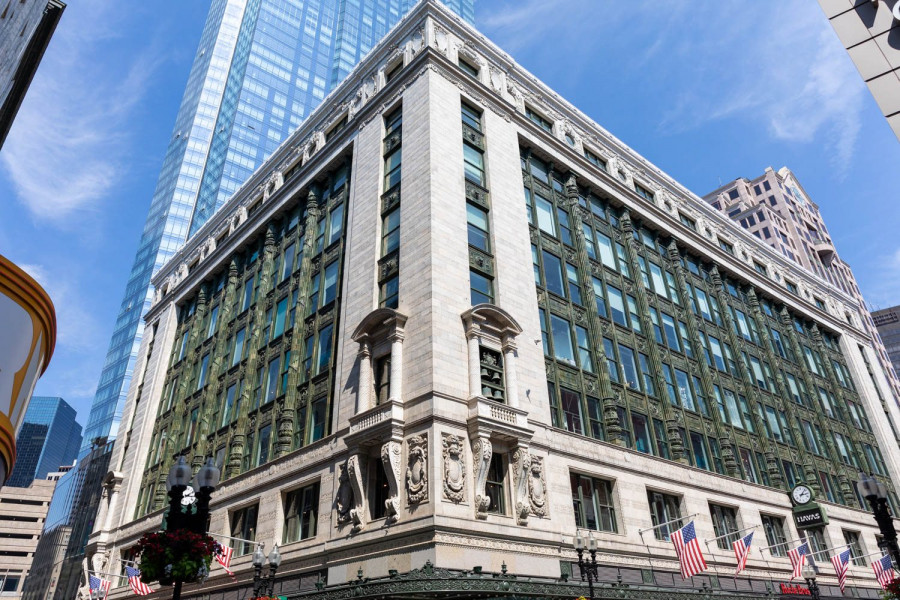
Photo past Eric Clark
78. Filene'southward
426 Washington St., Boston
Twelvemonth completed: 1912
Architect: Daniel Burnham & Company
Earlier Macy's took over the department store empire, there was a different chain in town. Filene's, named afterward its founder William Filene, opened in 1881, and quickly dominated retail across New England and New York in the 1900s. Renowned Midwestern architect Daniel Burnham was tasked with building a flagship store worthy of the speedily growing Filene's make. He modeled the store in the Beaux Arts style with grayness and green terracotta finishes on the facade, the last aspect of the original building that still stands under the protection of the Boston Landmarks Commission. Today, the inside of what is now widely referred to as the "Burnham Edifice" hosts office spaces every bit well as modern department shop chains.
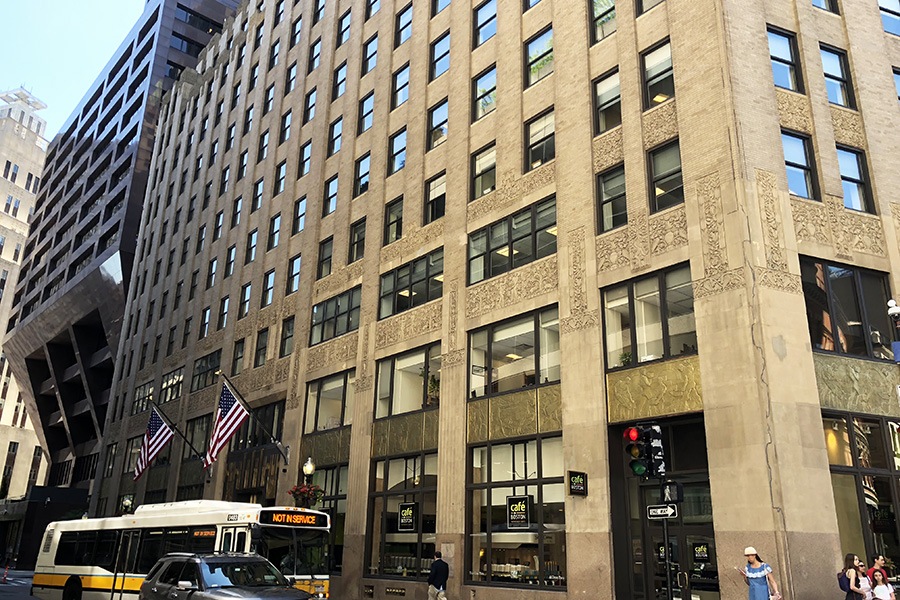
Photo by Madeline Bilis
77. 75 Federal
75 Federal St., Boston
Twelvemonth Completed: 1930
Architect: Thomas James
As it was built on the tail end of the Roaring 20s, this skyscraper reflects the Fine art Deco tastes of the period. It's adorned with bronze panels depicting the fields of finance, architecture and sculpture, agriculture, power, and transportation. Other panels show a carpenter, a stonemason, and a blacksmith. Before the edifice was constructed, the house of the commencement Roman Catholic Bishop of Boston, Jean Lefebvre Decheverus, stood at the spot.
76. Old Due north Church
193 Salem St., Boston
Year completed: 1723
Architect: William Price
1 if by land, two and a half feet of bricks make upwardly the walls of the Old N Church, where legend says Paul Revere held up two lanterns before rushing out on his midnight ride to run into the British, coming in from the sea. The church building's tall white steeple sticks out amid the brick-laden North Terminate, though its Georgian architecture is correct at home.

Photo via Wikimedia/Creative Eatables
75. Interdisciplinary Science & Engineering Complex at Northeastern University
805 Columbus Ave., Boston
Twelvemonth completed: 2017
Builder: Payette
Quietly and without fanfare, Northeastern University has risen in the college rankings over the past ten years, going from a New England academy into an international hub of innovation and research. Its campus buildings have grown along with information technology. In 2017, the towering glass Science and Engineering Complex was completed, featuring a broad central atrium that extends upward through all six floors of the edifice. The architects worked closely with the Northeastern administration to create a building that honored transparency and exuded an free energy and movement. Throughout the building, views of research spaces remain unobstructed through the utilise of glazed walls, offering anyone a peep in on what Stem students are upwardly to in the laboratories.

Photo by Simone Migliori
74. Clafin Building
20 Beacon St., Boston
Year completed: 1884
Architect: William Gibbons Preston
When you say "prime real manor" in Boston, you mean the Clafin Edifice. Steps away from the State House and the Mutual, the former Boston University building (now home to some of the almost expensive apartments in the urban center) combines arches and carved brownstone with striking copper bay windows.
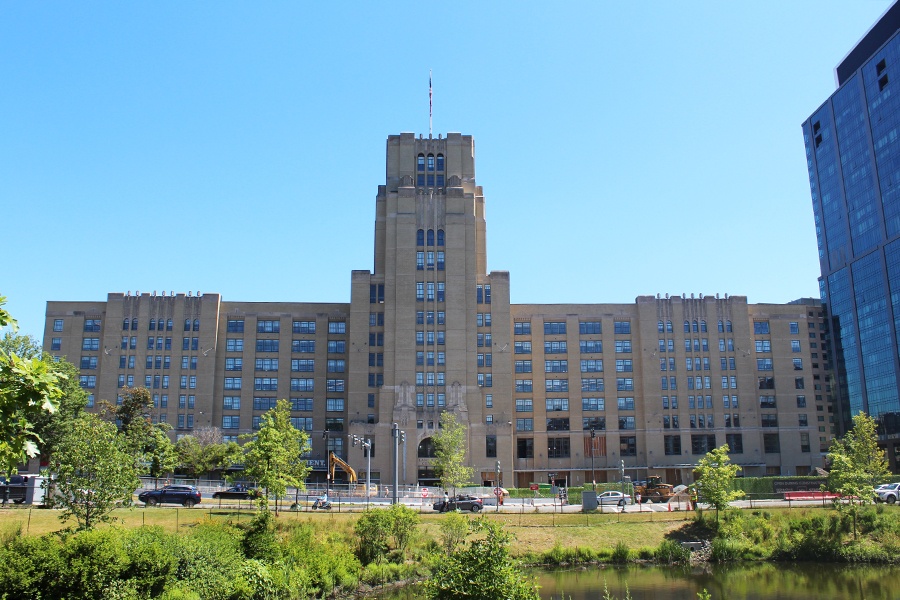
Photo by Ellen Gerst
73. The Landmark Center
401 Park Dr., Boston
Yr Completed: 1929
Architect: George C. Nimmons
This Art Deco structure looks like the hybrid of some moat-enclosed castle from the British countryside and the Chrysler building in New York. An unconventional combination, but it works. The building was offset used equally the Sears, Roebuck and Co. mail order store, and remains one of the best and largest examples of Art Deco compages in the city.

Photograph by Simone Migliori
72. YMCA of Greater Boston, Huntington Artery Branch
316 Huntington Ave., Boston
Year Completed: 1911
Architect: Shepley, Rutan, and Coolidge
The Huntington YMCA is nifty, rectangular, and perhaps best appreciated by Neoclassical architecture buffs. Though the residue of us might not discover the subtle stateliness exceptional, the building's history is certainly noteworthy–President William Taft laid the cornerstone in 1912 of the organization's flagship building.
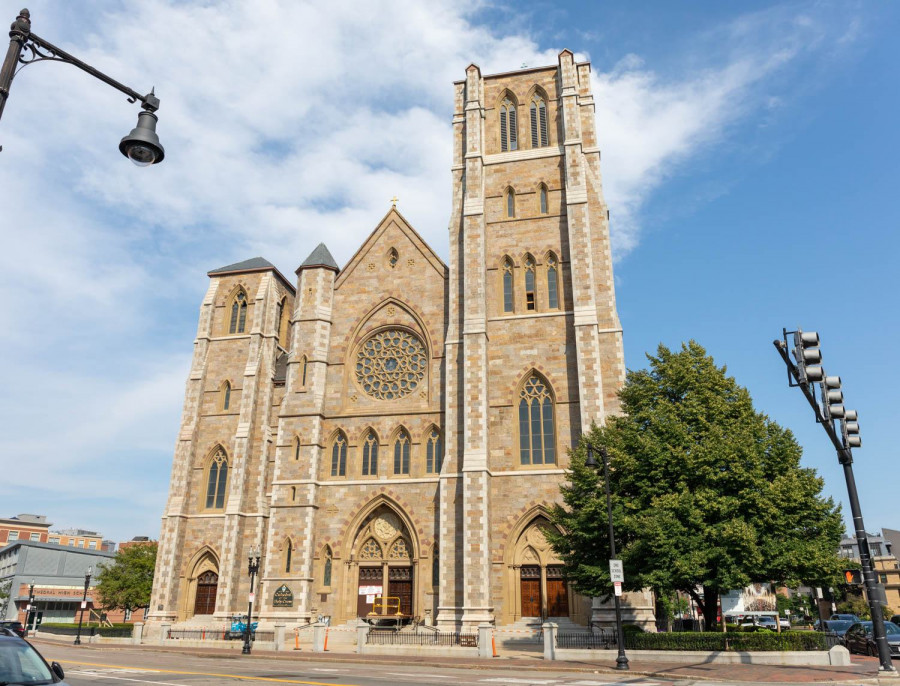
Photo past Eric Clark
71. Cathedral of the Holy Cross
1400 Washington St., Boston
Year completed: 1875
Builder: Patrick C. Keeley
In the belatedly 19th century, the South End'southward large population of Irish Catholics was in need of a place of worship, and someone decided that the spot of the former town gallows would practice quite nicely. The Cathedral of the Holy Cross, congenital in the Gothic Revival style with Roxbury puddingstone and limestone trim, became the largest Roman Catholic church in New England—as big as London'due south famous Westminster Abbey.

Photo by Eric Clark
70. Boston Fire Department, Engine 33, Ladder 15
941-955 Boylston St., Boston
Year completed: 1887
Architect: Arthur H. Vinal
With a burnished brick facade and a Richardsonian Romanesque twin rooftop blueprint, this vintage fire station—the starting time to house a ladder truck in Boston—is still agile. Boston Burn down Department Engine Company 33 and Ladder Company xv have upward half of it. Boston Architectural Higher purchased the other one-half in 2007. An enclosed courtyard that bridges the 2 buildings connects the twin rooftops. Back in the day, the courtyard independent shared stables for the burn and constabulary horses .
69. James Blake Firm
735 Columbia Rd., Dorchester
Year completed: 1661
Architect: James Blake
English immigrant and minister James Blake settled in the boondocks of Dorchester in the 1630s. Soon afterward, he met his wife Elizabeth Clap. Allegedly, this modest house was built in grooming for their wedlock. Every bit the oldest firm in Boston, the James Blake House certainly gets a lot of attention (and bout groups). Though simple and unassuming, and built in the rustic Western English language style of his time, Blake's family home is distinguished for its history and age, and the dedicated preservation efforts of the Dorchester Historical Society.
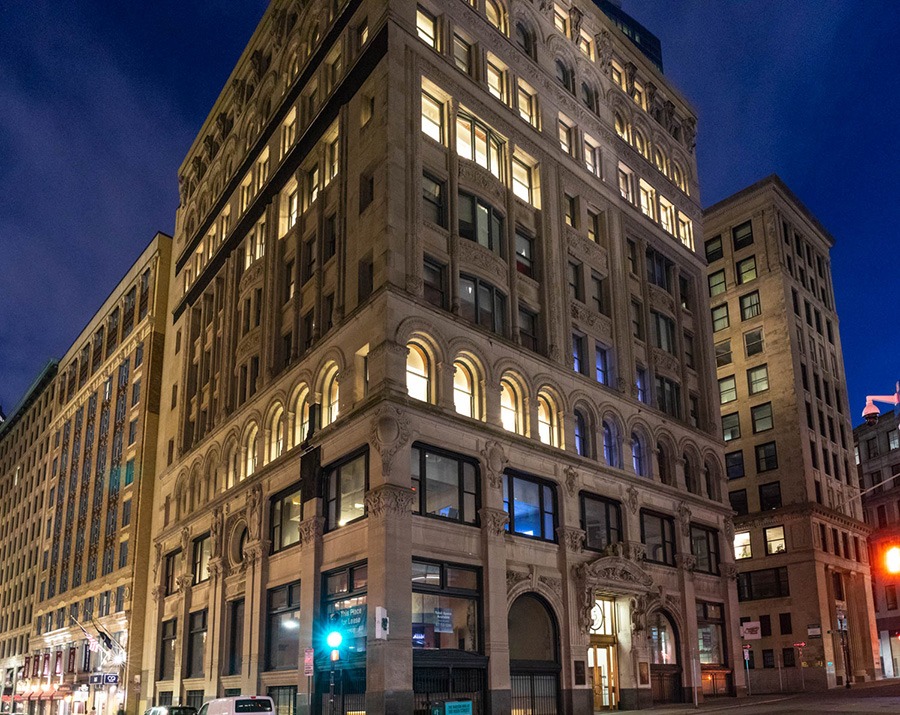
Photograph by Eric Clark
68. The International Trust Visitor Building
45 Milk St., Boston
Twelvemonth completed: 1893, enlarged in 1906
Architect: William Gibbons Preston, enlarged by Woodbury & Leighton
This building, plunked in the heart of downtown Boston, is an early example of the now widely used construction technique known every bit "skeleton framing," where an interior skeleton comprised of the primary building fabric is fashioned before the rest of the structure goes up. Originally congenital as the home office for the Onetime Colony Trust Visitor division of the Banking concern of Boston, this elaborately designed Beaux Arts role space had anthropomorphic figures carved into it by the 19th-century rock carver Max Bachman. The figures, which correspond Commerce, Industry, Security, and Fidelity, linger between the windows of the second flooring.
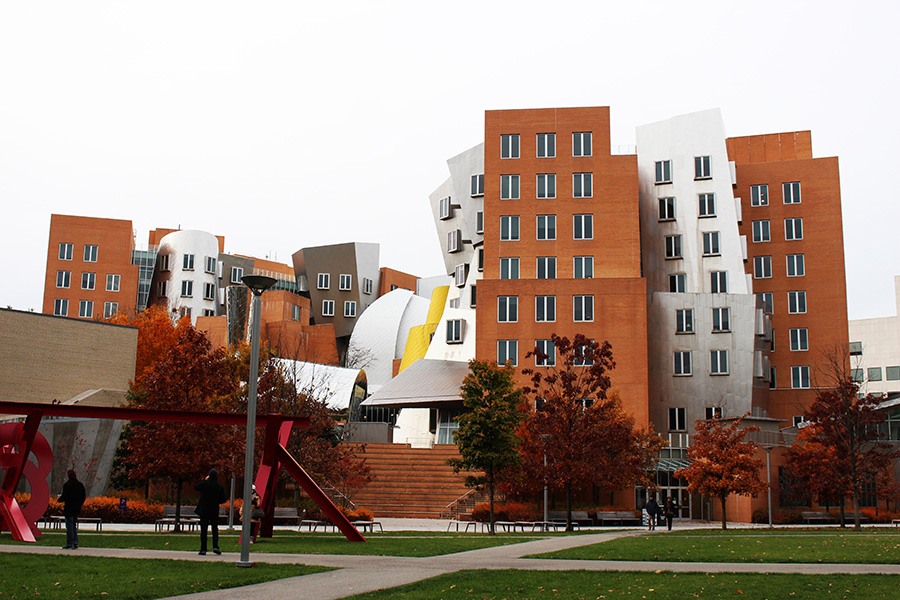
Photo by Margaret Burdge
67. Ray and Maria Stata Eye
32 Vassar St., Cambridge
Year completed: 2004
Architect: Frank Gehry
The Stata Center was the looney brainchild of Frank Gehry, one of the virtually prominent contemporary architects of our time (thinkGuggenheim Museum in Kingdom of spain orDancing Business firm in Prague). The center serves equally a science edifice on MIT'southward campus, presumably in the hopes that the cartoonish Deconstructivist design inspires students to think unconventionally.
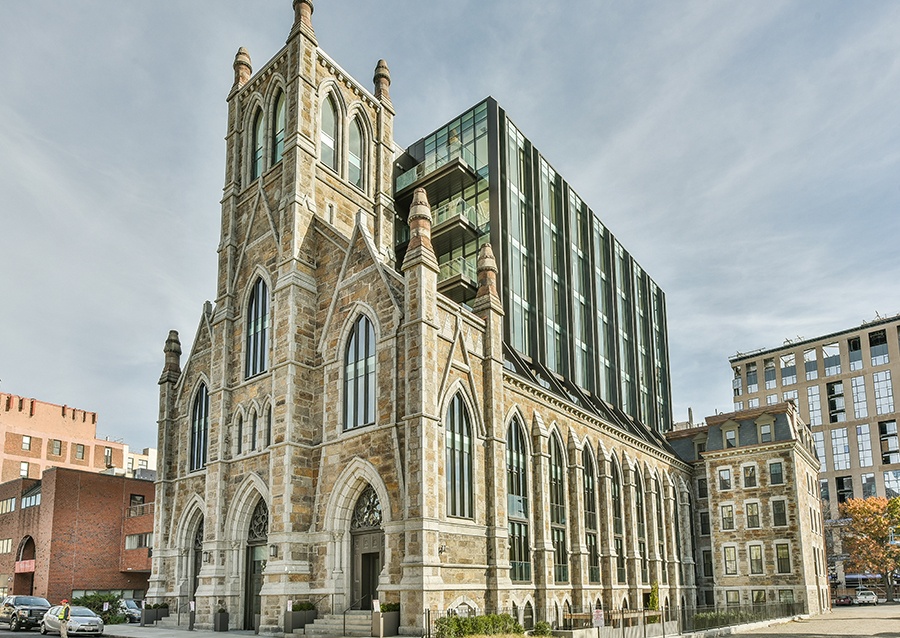
Photo courtesy of Coldwell Broker Residential Brokerage
66. The Lucas
140 Shawmut Ave., Boston
Year completed: 1874, converted in 2017
Architect: Finegold Alexander Architects
In 2017, the 19th-century Holy Trinity German Catholic Church's quondam congregation space was completely transformed into luxury condominiums, while preserving the stately and celebrated Gothic puddingstone exterior. The resulting hybrid is a combination of the styles of ii centuries—ane comprised of rough rock, the other a geometric complex of smoothen glass and steel.

Photo via Wikimedia/Creative Commons
65. Abbotsford
300 Walnut Ave., Roxbury
Year completed: 1872
Architect: Alden Frink
This impressive loftier Victorian Gothic mansion is built entirely from Roxbury puddingstone. In its lifetime, the building, with its pointy window arches, has been a dwelling for Boston Lead Works' owner Aaron Davis Williams, a disciplinary school for boys, and now, the Museum of the National Centre of Afro-American Artists.
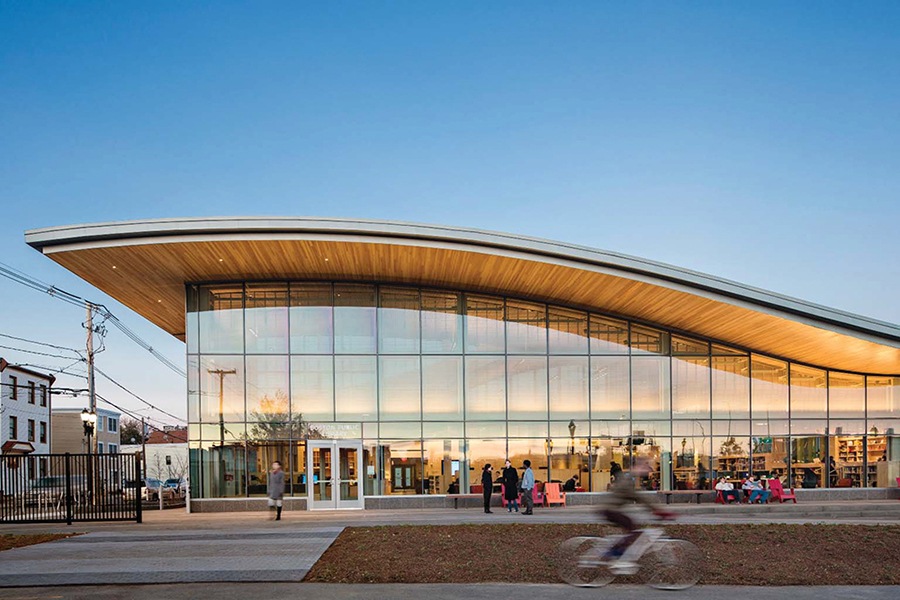
Photograph by Robert Benson
64. Due east Boston Co-operative of the Boston Public Library
365 S Bremen St., East Boston
Year completed: 2014
Architect: William Rawn Associates
One of the Boston Public Library'south newest outposts takes neighborhood libraries from nighttime carpets and old computers to one modern, lite-filled room. A swooping wooden roof and wall-to-wall windows offering plenty of light for reading, and yes, fifty-fifty mooching WiFi. The Eastie branch is a reflection of the chop-chop growing neighborhood it occupies—information technology's LEED Aureate Certified, looks out at an 18-acre park, and is surrounded past tiles that indicate to the tiptop 21 countries of origin for East Boston residents. The edifice won the architectural honor of the Harleston Parker Medal in 2017.
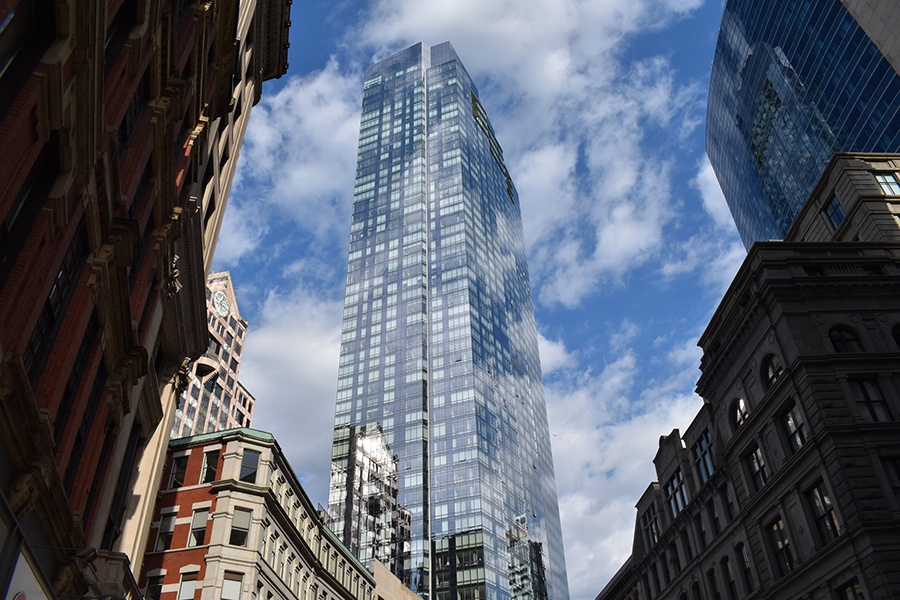
Photo past Jules Struck
63. Millennium Tower
ane Franklin St., Boston
Year completed: 2016
Architect: Blake Middleton of Handel Architects
Look up at the Boston skyline in the evening and ane building stands out—non just for its architecture, only for the image of the dusk sky that information technology mirrors. Millennium Tower's crystalline exterior and sharp geometric angles give the edifice a futuristic appearance. And the luxury high-rise is certainly not an eyesore. In fact, it fixed one. Office of the original Filene's store was gutted earlier the 2008 recession, leaving a gaping hole in downtown Boston. Indeed, the city's tertiary-tallest building filled that pit with over 400 impressively expensive residences.
62. The Great Dome at MIT
77 Mass. Ave, Building 10, Cambridge
Twelvemonth completed: 1916
Architect: William Welles Bosworth
Information technology was supposed to be a jumbo assembly hall. Simply to the disappointment of Tim the Beaver, the university opted instead to upkeep for a smaller lecture hall and the Barker Engineering library. All the same, the Neoclassical Nifty Dome and its perimeter of Corinthian columns is a commanding presence in the eye of MIT'southward campus—much like its inspiration, the Low Memorial Library at Columbia University. Both are modeled off of Rome's famous Pantheon, though they worship knowledge in identify of Roman gods.
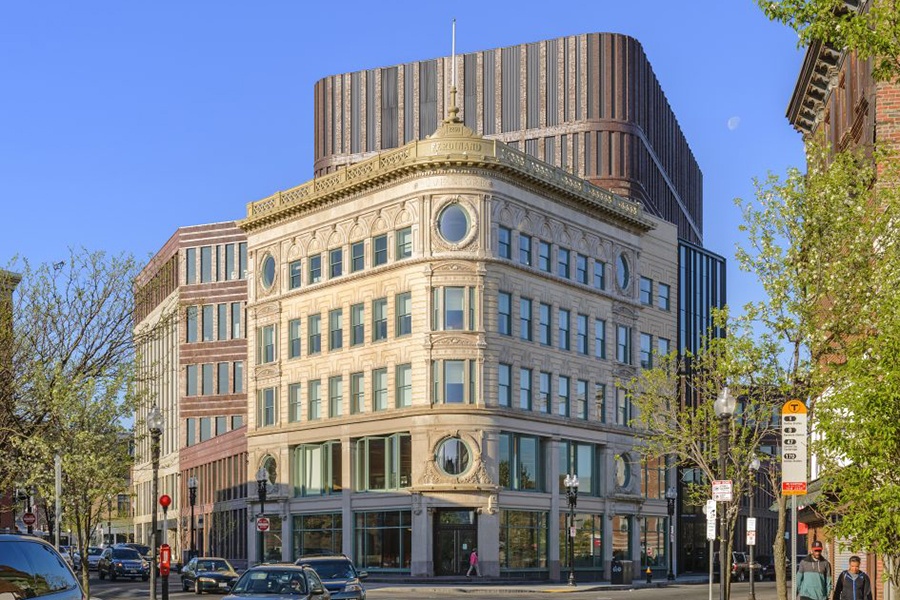
Photograph © Anton Grassl | ESTO
61. Bruce C. Bolling Municipal Edifice
2300 Washington St., Roxbury
Year completed: 2015
Architect: Mecanoo with Sasaki
The tardily Mayor Thomas 1000. Menino had a dilemma: the Boston Public School department needed a new office building. Architectural firm Mecanoo had an idea. Starting with the attractive limestone and terra cotta facade of Roxbury'south historic Ferdinand building, the architects combined two more historic facades—that of the granite Waterman and reddish brick Curtis—to create a new Modern Baroque building. The combination of these facades makes the Bruce C. Bolling edifice—named for the first black president of Boston's Urban center Council—a unique fixture of Dudley Square.
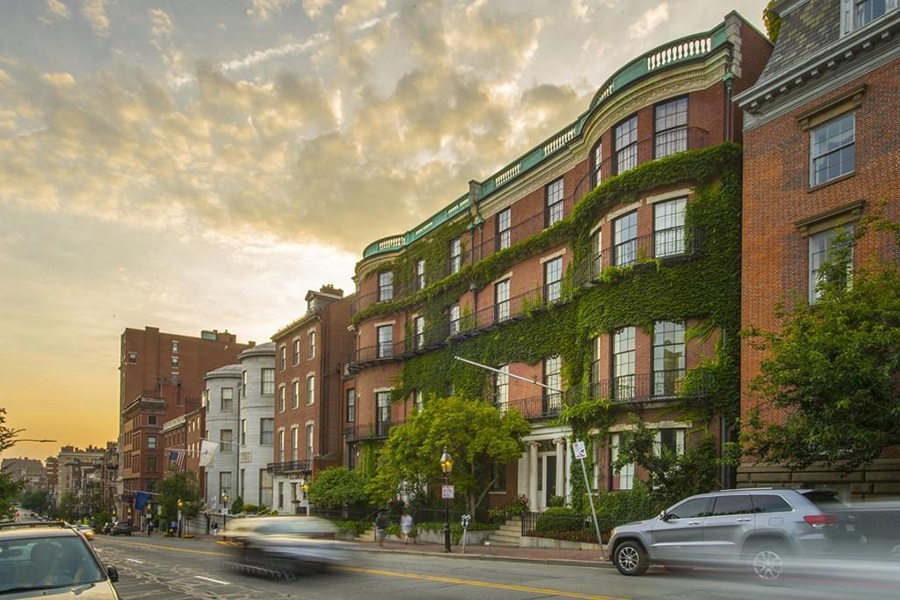
Photo by Randy Robinson Photography
threescore. Nathan Appleton Residence
39-twoscore Beacon St., Boston
Yr completed: 1818
Architect: Alexander Parris, with additions by Hartwell and Richardson in 1888
In 1818, cloth manufacturer Nathan Appleton and his business partner, Daniel Pinckney Parker, tore down some old buildings on Beacon Street to build some brownstones. Their new twin townhouses, designed in the Greek Revival style, accept stood there since, complete with Ionic columned porches and wrought-iron summer balconies. In 1843, the poet Henry Wadsworth Longfellow married Appleton's girl, Fanny, there, earning these red brick buildings a identify in the National Celebrated Landmarks registry in 1977.

Photo by Alex Lau
59. Symphony Hall
301 Massachusetts Ave., Boston
Twelvemonth completed: 1900
Builder: McKim, Mead, and White
Originally intended to be named "Boston Music Hall," Symphony Hall houses the first auditorium specifically designed with scientific acoustical principles in mind. Modeled afterward a similarly striking building in Germany, the place is thought to be ane of the finest concert halls in the world. Before taking up residence in Symphony Hall, the famed Boston Symphony Orchestra spent a few years in the onetime Boston Music Hall on Winter Street. Founded in 1881, the BSO moved to Symphony Hall upon the building's completion in 1900, with the Boston Pops Orchestra not far backside.

Photograph by Jules Struck
58. Boston Opera Business firm
539 Washington St., Boston
Year completed: 1928
Architect: Thomas Westward. Lamb
Starting in the Roaring 20s, the opera house dazzled visitors catching movies on the big screen at what was so called the B.F. Keith Memorial Theatre. By the 21st century, the building became derelict, and an all-encompassing restoration projection was launched to return it to its erstwhile splendor. The restoration brightened upward the interior's gold leaf finishing, Carrera marble, paintings, and tapestries. The grand staircases and chandeliers, as well as the oak and silk paneling were reinvigorated. At present abode to the Boston Ballet, the Boston Opera Firm reopened with a bear witness of Broadway's "The Lion King" in 2004, and hosts enchanting performances of "The Nutcracker" every Christmas flavour.
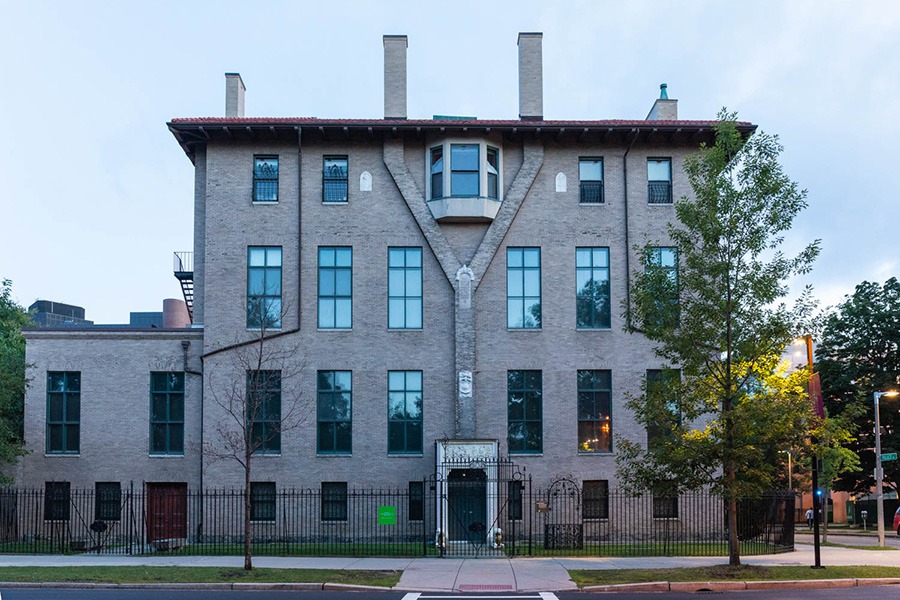
Photo by Eric Clark
57. Isabella Stewart Gardner Museum
25 Evans Way, Boston
Yr completed: 1902
Architect: Willard T. Sears
It'south a wonder to retrieve that at 1 time, the Isabella Stewart Gardner Museum, formerly known as Fenway Court, was actually Gardner'southward private home. The museum, inspired past Venice's 15th-century Palazzo Barbaro, houses an enchanting four-story central courtyard, roofed in drinking glass and so that the natural sunlight streams in. Arches interspersed with colonettes surround the verdant courtyard, which guests tin can overlook through windows and balconies from the upper levels. Gardner'southward influence on the design is profound, and her ownership lingers. When she died in 1924, her will decreed that the museum must remain exactly as she left it—with all her unique art and decorative effects in place.

Photo courtesy of Engel & Volkers Boston
56. McLauthlin Building
120 Fulton St., Boston
Yr Completed: 1864
Architect: Unknown
The McLauthlin building is one of New England's earliest examples of a cast-fe and brick façade, a mode often seen in New York but comparatively uncommon for Boston. The building used to be a manufacturing institute for the McLauthlin Elevator Company, simply in the '70s information technology was converted into condominiums. The beautiful exterior remains mostly unchanged.
55. Rex'south Chapel
58 Tremont St., Boston
Twelvemonth completed: 1754
Architect: Peter Harrison
The dark Quincy granite and imposing Ionic colonnade at the forefront of this landmark on the Liberty Trail certainly doesn't await like it was thrown together, just parts of its parent structure were. Thrown out the window, that is. The original building, a pocket-sized wooden chapel, was crafted for Anglican British officers, making it very unpopular with Bostonians in the neighborhood. The new Georgian-style chapel was congenital around the existing wooden structure so church building services could go along during structure. When it was finished, builders disassembled the old wood and literally chucked information technology through the church'south biconvex windows. These days, historic Rex'due south Chapel is merely steps from Metropolis Hall, and serves as an independent, Christian Unitarian congregation.

Photo by Eric Clark
54. 500 Boylston
500 Boylston St., Boston
Yr completed: 1989
Architect: John Burgee Architects with Philip Johnson
Y'all might recognize the within of information technology from the early 2000s comedy Boston Legal, as the testify's Crane, Poole & Schmidt police firm occupied the 14th, 15th, and fictional 28th floor. This rose-granite, postmodern behemoth towers over Copley Square. What makes 500 Boylston truly phenomenal is its archway courtyard, composed of two symmetrical "wings" made up of soaring columns.
53. Starting time Baptist Church
110 Commonwealth Ave., Boston
Twelvemonth Completed: 1872
Architect: H.H. Richardson
The Beginning Baptist Church's shadowy walkways and creeping vines offer a peaceful respite from the noisy city streets. The building is a gorgeous Romanesque breastwork, like to nearby Trinity Church building, done by the same builder. The Baptist church building, however, was Richardson'south first church in the city. The spectacular friezes on the edifice's tower were designed by Federic Auguste Bartholdi, who likewise happened to design the Statue of Liberty.
52. Christian Science Church
250 Mass Ave., Boston
Year completed: 1906
Architect: Franklin I. Welch, Charles Brigham, S.South. Beman
The Mother Church of Christian Science looks more than like it belongs in Renaissance Italy than the Back Bay. The original blueprint, by Mary Baker Eddy herself, was in the fashion of a more traditional New England church earlier information technology was expanded in 1906 to the ornate landmark information technology is today. The final affect, the portico with its Corinthian columns, was completed in the '70s.

Photo by Jules Struck
51. Suffolk County Courthouse
1 Pemberton Square
Year Completed: 1894
Architect: George A. Clough
Serious and purple, this building fits with the swishing of black robes, the bang of a gavel, the suggestion of justice being served. The classical structure, as well known as the John Adams Courthouse, was originally a footling shorter, but in 1909 the land decided that law and club required more than room, so the architect added 2 stories.
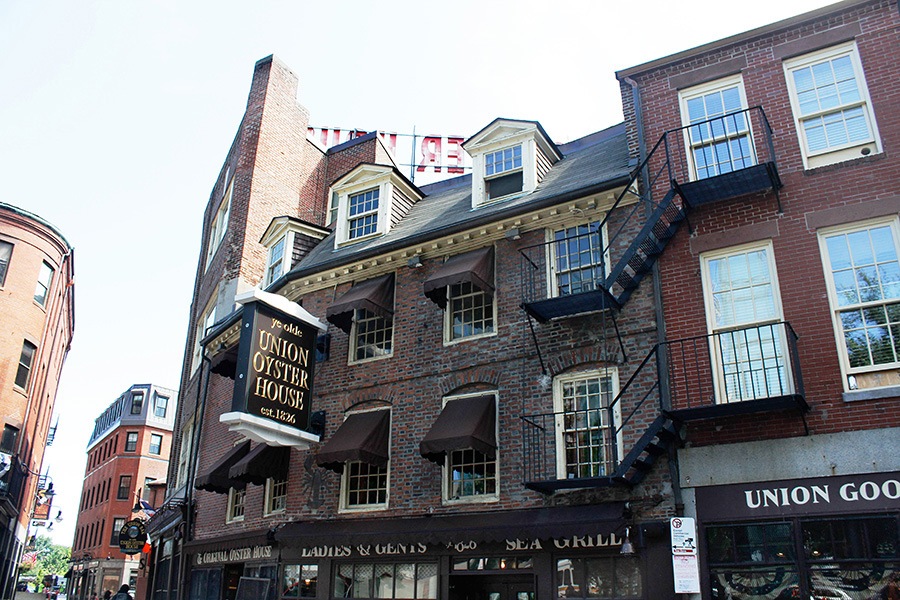
Photo by Simone Migliori
50. Wedlock Oyster House
41 Union St., Boston
Twelvemonth Completed: 1704
Builder: Unknown
The Matrimony Oyster House is as a office of Boston as the streets themselves. This immovable Georgian cornerstone of the urban center seems to have stayed the same since 1826. The building has hosted numerous high-profile guests over the years, even serving as the hidey-pigsty for Louis Philippe, King of France, from 1830 to 1848 during his exile.

Photo by Ellen Gerst
49. The First Harrison Gray Otis Business firm
141 Cambridge St., Boston
Year completed: 1795
Builder: Charles Bulfinch
The Otis House, a bulky hunk of history straddling Beacon Loma and the Westward End, is the neighborhood's concluding holdover from the original Bowdoin Square days. (So, none of that urban renewal stuff.) It's a landmark case of Federal style, a perfect cube of brilliantly preserved ruddy brick with none of the frills. Information technology was moved backward during street widening in 1925.
48. Fairmont Copley Plaza
138 St James Ave, Boston
Year Completed: 1912
Architect: Henry Janeway Hardenbergh
This Beaux Arts staple is clean and classy, fitting for an elite hotel. The Fairmont'southward limestone details and buff brick walls are understated however impressive, and the plaza view isn't so bad, either. It was built on the original site for the Museum of Fine Arts.

Photo by Eric Clark
47. Boston Chinese Church of Saving Grace
115 Broadway, Boston
Year completed: 1934
Architect: Blackall, Clapp and Whittemore
It was just 100 years agone that Boston'due south smallest neighborhood , Bay Hamlet , was a hub for film distribution. Art Deco-mode warehouses sprang up in the early 20th century, including this one at 115 Broadway. Built for 20th Century Play a joke on, the boxy building is now home to the Boston Chinese Church building of Saving Grace. You lot can still glimpse its columns, scallops, and Art Deco flourishes from the street.
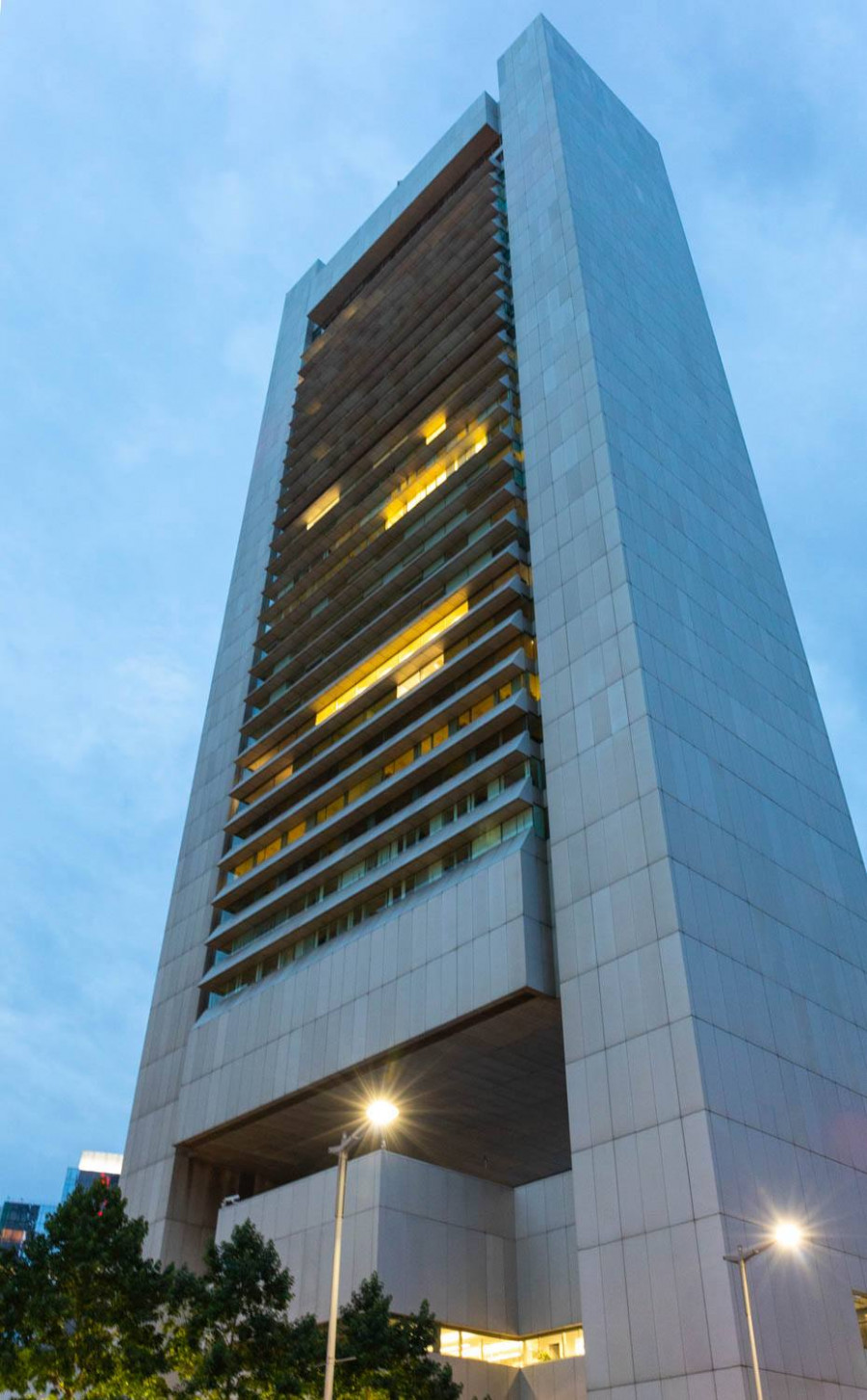
Photo by Eric Clark
46. Federal Reserve Banking concern of Boston
600 Atlantic Ave., Boston
Twelvemonth Completed: 1977
Builder: Hugh Stubbins Jr.
This heavy edifice is not subtle. Huge and powerful is more like it. The Federal Reserve Banking company stands solidly over the urban center like some angular cousin of the Easter Island heads. It's sometimes called the "washboard edifice," for obvious reasons.
45. Skinny Firm
44 Hull St., Boston
Year completed: 1884
Architect: Unknown
Nestled between two brick buildings in the North End, this stake green construction was built in 1884 out of spite . Co-ordinate to fable, two brothers inherited a plot of country in the neighborhood from their father. After serving in the Civil War, one brother came home to find that his brother had congenital a big firm on their shared land. Miffed, he built what'due south been affectionately dubbed the Skinny House, blocking sunlight and his blood brother's views of the harbor. The i,166-foursquare-foot abode is virtually 10 feet wide by 30 anxiety long. Information technology also has no forepart door from the street—the primary entrance is in a side aisle.

Photograph by Ellen Gerst
44. Restoration Hardware Building
234 Berkeley St., Boston
Year completed: 1863
Architect: William Gibbons Preston
Built in the French Academic fashion to suit its original use as Boston'south Museum of Natural History, the edifice that now houses a Restoration Hardware showroom is more elegant enough to match the wares it sells. A recent renovation by Backen, Gillam & Kroeger updated information technology with a modern glass entryway and a glass-walled elevator that anchors the eye of the exhibit, surrounded by luxe chandeliers and mirrored arches.

Prototype courtesy of Rasky Partners, Inc.
43. One Dalton
One Dalton St., Boston
Twelvemonth completed: 2018
Architect: Henry Cobb
One Dalton , gear up to open as the Four Seasons Hotel & Individual Residences in late 2018, rises 61 stories in Back Bay. It stands just beyond from the Christian Science Centre Administration Edifice done by I.K. Pei, Cobb'due south longtime friend and cofounder of his business firm, Pei Cobb Freed & Partners. Poised to be the tallest residential tower in New England at 740 feet loftier, the building is clad entirely in glass. It's meant to resemble a "soft triangle," with three curved faces and 3 distinct sections meant for public space, hotel rooms, and private residences.
42. Kresge Auditorium
W16, 48 Massachusetts Ave., Cambridge
Twelvemonth Completed: 1955
Architect: Eero Saarinen
Similar some huge, pearlescent leaf, this artful auditorium's domed roof is expertly counterbalanced on just three points. It's actually the third roof since 1955—the original white orastone was replaced with pb sheeting and finally copper in the 1980s. Copper was the preferred cloth of Eero Saarinen, simply in the '50s, it puzzled builders how to implement it.
41. The Ether Dome
55 Fruit St., Boston
Year Completed: Opened 1821
Architect: Charles Bulfinch, Alexander Parris
The Ether Dome is the crown on the Bulfinch Building, property of Mass. General Hospital. Its rounded roof tin be seen at the eye of the Greek Revival structure. Visitors are allowed to check out the inside of the dome—information technology's a old surgical amphitheater where ether was showtime used in an operation.
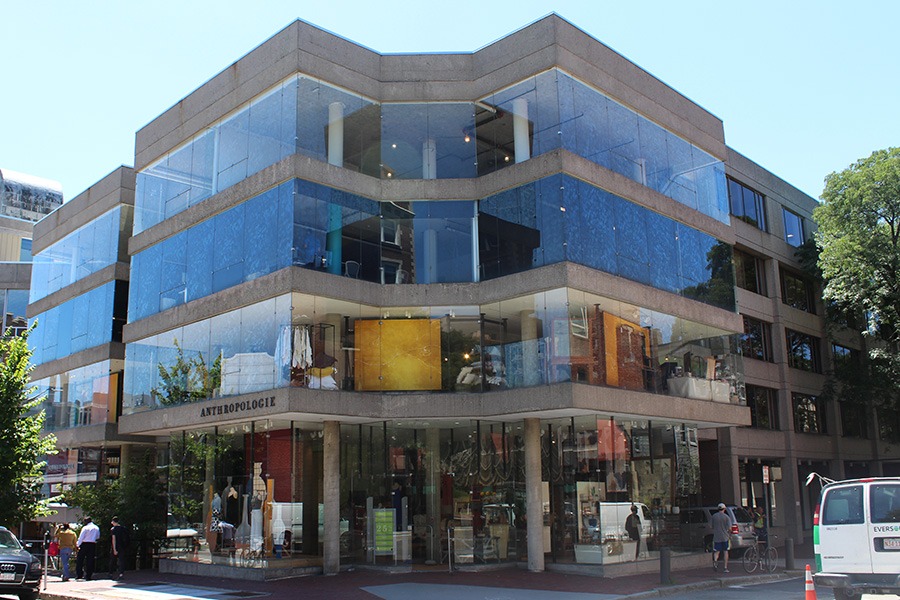
Photo by Ellen Gerst
twoscore. The Architects' Corner
44-48 Brattle St., Cambridge
Twelvemonth completed: 1966-1971
Builder: The Architects Collaborative
In addition to existence a stunning sculpture of concrete and glass, the Architects' Corner has quite the history. The sparkling jewel amongst Cambridge's bricks was a neighbour for the home of architecture dream squad The Architects Collaborative—made up of eight influential architects including Walter Gropius. It was also the site of legendary (and now defunct) retailer Design Research, founded past The Architects Collaborative member Benjamin Thompson, likewise every bit the offices of Sert, Jackson & Assembly, and Benjamin Thompson & Associates. In recent years, the grouping of buildings has housed Crate and Barrel and Anthropologie.
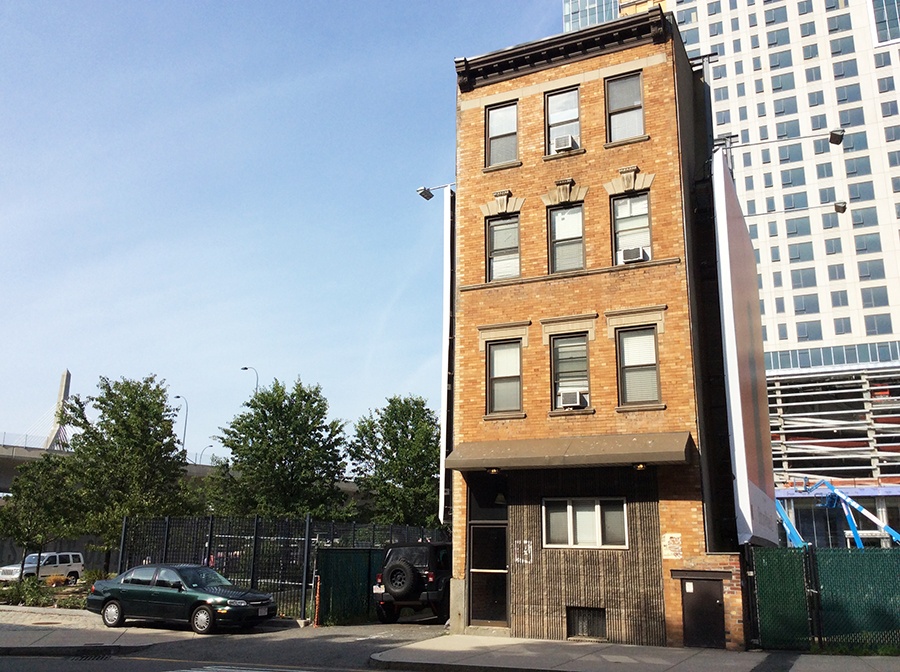
Photograph by Gabrielle DiBenedetto
39. The Last Tenement
42 Lomasney Manner, Boston
Year completed: 1870s
Builder: Unknown
The edifice at 42 Lomasney Manner stands eerily and singularly, and with a startling corporeality of open space around it. Known as the Last Tenement, the three-story, xanthous brick structure is the final vestige of the sometime Due west End, pre-Urban Renewal. It somehow survived when the neighborhood around it was razed, and stayed standing equally train lines, highways, and the TD Garden sprang upwardly around it. It'southward been clad with billboards for years and is still home to a few lucky tenants.
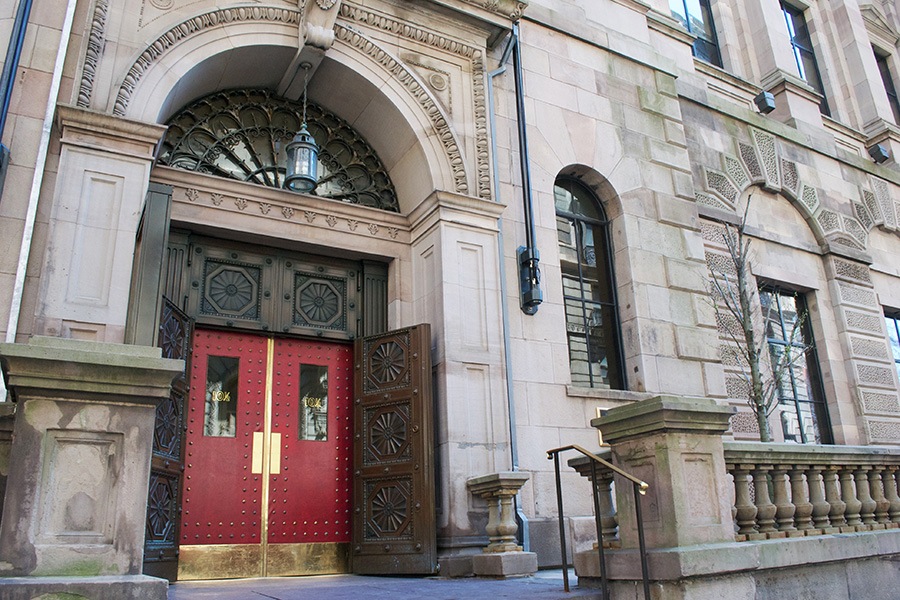
Photograph by Madeline Bilis
38. Boston Athenaeum
10 ½ Beacon St., Boston
Year completed: 1849
Architect: Edward Clarke Cabot, Henry Forbes Bigelow
The Athenaeum is cited equally one of the first major examples of the revival of Italian Renaissance compages. According to the Society of Architectural Historians, information technology became a pop style of building for cultural organizations in the belatedly nineteenth century. Equally 1 of the country's primeval membership libraries, the Athenaeum was created with space for both art and books in mind. In 1913, two floors were added to the edifice. They were set back so equally not to disturb the original facade of the building, and brought it to a total of half-dozen levels, including the basement conservation lab .

Photo by Simone Migliori
37. 50.A. Burdick'south
220 Clarendon St., Boston
Yr Completed: 1883
Architect: M. W. Brown
The little abode at 220 Clarendon St. has stood proudly (admitting its superlative) since 1883. More than a century later, in 2012, L.A. Burdick's opened at the spot. An infinitely delicious—and somewhat unexpected-looking—chocolate store seems to be a perfect fit for the cozy stucco house, no?

Photograph by Alex Lau
36. Paramount Theatre
559 Washington St., Boston
Year completed: 1932
Architect: Arthur Bowditch
Before the AMC or the Regal, if yous wanted to see a movie in Boston, you lot had to head to the Paramount. With timeless Art Deco details within and out—from the master-colored marquee and sign painted with scenes from mythology, the now-Emerson College-owned theater is a trip back to a time when popcorn and a ticket didn't cost you your entire paycheck.
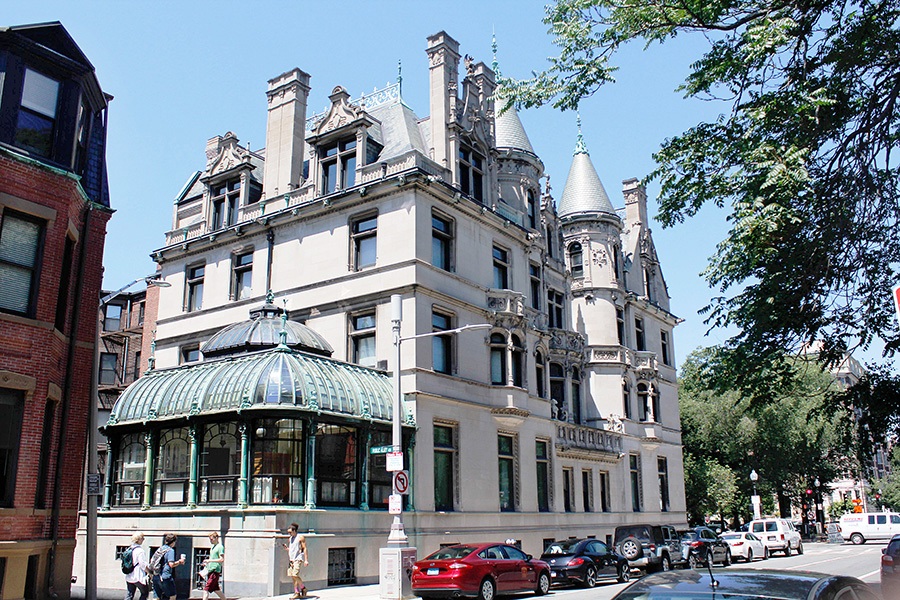
Photograph by Simone Migliori
35. Burrage Mansion
314 Republic Ave., Boston
Twelvemonth completed: 1901
Architect: Charles Brigham
It looks like a chateau that belongs in the French countryside, but Albert Burrage'south mansion sits right on Comm. Ave. Turrets, balconies (plural), and intricately carved moulding reflect Burrage'due south taste for the effectively things in life—shared today by one-time resident Tom Brady.
34. Harbor Towers
65-85 E Republic of india Row, Boston
Year completed: 1971
Builder: Henry Cobb, I.Grand. Pei & Partners
Another example of Boston's fraught relationship with Brutalism, the Harbor Towers soar —or loom, if you dislike them—40 stories over the waterfront. The towers, which are some of the just high-rise buildings forth the harbor, are sandwiched between the Aquarium and the boats lining Rowe'south Wharf. While nosotros happen to similar them, the city is divided on how information technology feels.
Many people have said the all-time thing about living in the Harbor Towers is not having a view of the Harbor Towers. (To that we say: Why fifty-fifty motility into the Brutalist beauties at all with that attitude?) And yet builder Harry Cobb, who worked on the project, seems to understand. "I do not regard Harbor Towers as my best attempt in Boston," Cobb said to Boston in a 2008 e-mail. "I am sympathetic to those who believe that in the perspective of history this could be seen as the wrong project in the incorrect identify at the wrong time."
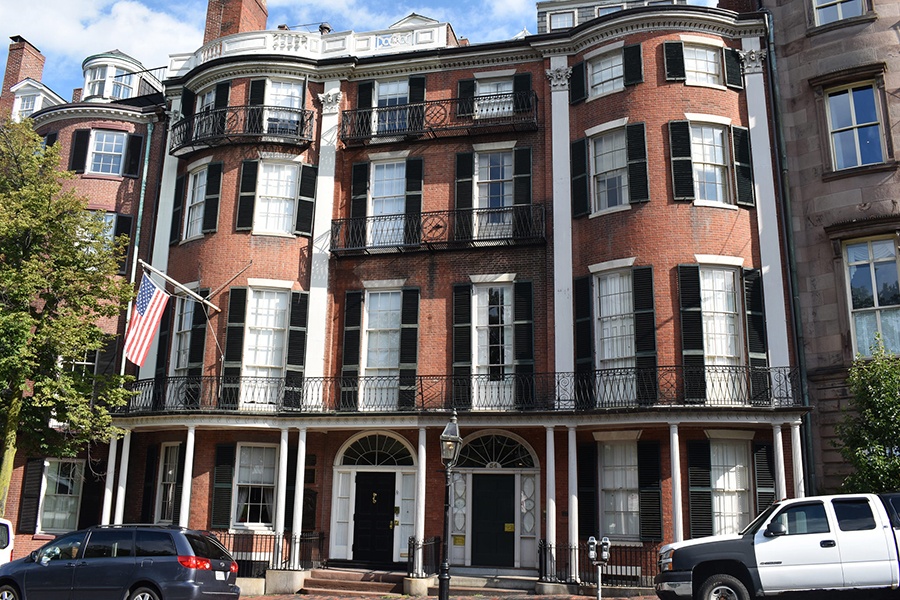
Photo by Jules Struck
33. William Hickling Prescott House
55 Beacon St., Boston
Year completed: 1808
Architect: Asher Benjamin
This impressive Federal-manner construction stands apart from its fellow brick neighbors, thanks to unique rounded bay fronts and white columns. It was built overlooking the Common in 1808 for a merchant named James Smith Colburn, and on country once owned by portrait painter John Singleton Copley to kick. In 1845, historian William Hickling Prescott moved into the business firm, and about a century later, it was purchased by the National Society of Colonial Dames. The dwelling is now open up as a business firm museum select Wednesdays and Saturdays.

Photo past Eric Clark
32. Old John Hancock Building
200 Berkeley St., Boston
Year Completed: 1947
Architect: Cram and Ferguson
Besides referred to as the Berkeley Building, the One-time John Hancock Edifice stands proudly every bit the 19th-tallest edifice in Boston. When information technology was congenital in 1947, all the same, it was the second-tallest. The Art Deco-style tower was topped off with a conditions beacon in 1950. The beacon's calorie-free flashes red and blueish to relay atmospheric condition reports. Here'south the old maxim that helps decipher what the lights hateful: " Steady blue, clear view. Flashing blue, clouds due. Steady red, pelting ahead. Flashing red, snow instead."
31. Arsenal of the First Corps of Cadets
101 Arlington St., Boston
Year completed: 1897
Architect: William Gibbons Preston
Once an impenetrable armory for the First Corps of Cadets, and so later (well, until May 2018 ) a Smith & Wollensky steakhouse, this medieval-fashion castle is an Arlington Street icon. If you were to climb all the way past that beautifully laid stonework and stand on top of the tower, y'all would be able to send a signal to the State Business firm. You couldn't expect a response, though, as it hasn't been used as a military postal service in over 50 years.
30. Paul Revere Firm
nineteen Due north Foursquare, Boston
Year Completed: 1680
Builder: John Jeffs
Architecturally, this Elizabethan Tudor-style house is just another case of the abundant Colonial-era buildings around Boston. Still, it's pretty cool to run into where Paul Revere spent his time when he wasn't announcing impending revolutions.

Photo by Alex Lau
29. Museum of Fine Arts
465 Huntington Ave., Boston
Year completed: 1909
Builder: Guy Lowell
The MFA is a masterclass in Classical compages, inside and out. Visitors walk under Ionic columns at the archway, climb up into a rotunda under a dome and wander through galleries whose ceilings are decked with moulding and coffers. Although the exterior is uniformly Beaux Arts, new wings and galleries inside come from the modernistic, postmodern, and fifty-fifty quasi-Brutalist movements.
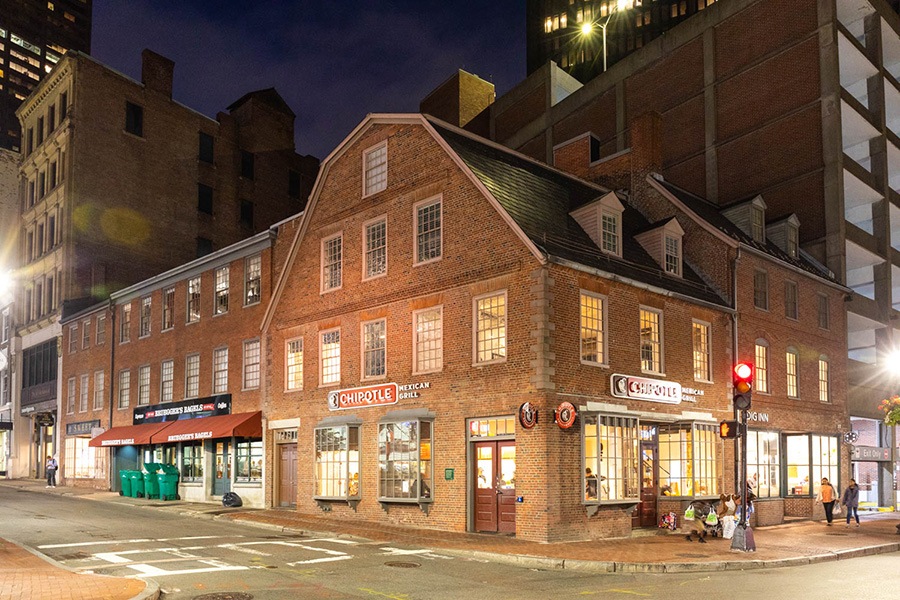
Photo by Eric Clark
28. Old Corner Bookstore
iii School St., Boston
Twelvemonth completed: 1718
Architect: Unknown
On the former site of Anne Hutchinson'south woods-framed house stands the One-time Corner Bookstore, now abode to a Chipotle and a Bruegger'due south Bagels. Later, Thomas Pucker congenital the electric current sloping gambrel-roofed structure to house his apothecary before it was turned into the Ticknor & Fields (Little Women , The Scarlet Letter ) publishing house.
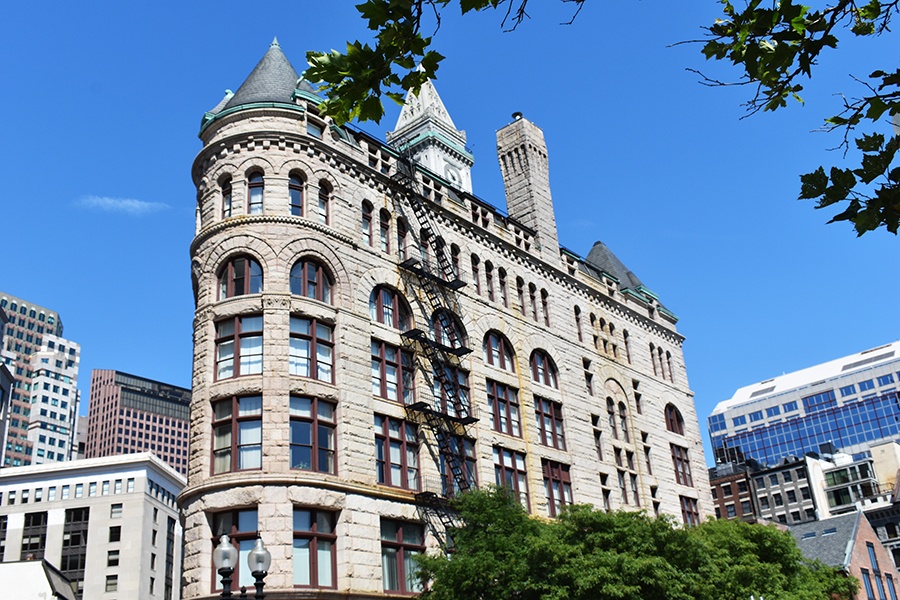
Photo by Jules Struck
27. The Flour & Grain Exchange Building
177 Milk St., Boston
Twelvemonth completed: 1892
Architect: Shepley, Rutan, and Coolidge
If it'south possible for i structure to look similar an role building, castle, and medieval church all at the same time, the Flour and Grain Commutation does just that. Its crowned turrets jut out from a Romanesque base with the style'south signature rounded windows, all done in pink Milford granite.
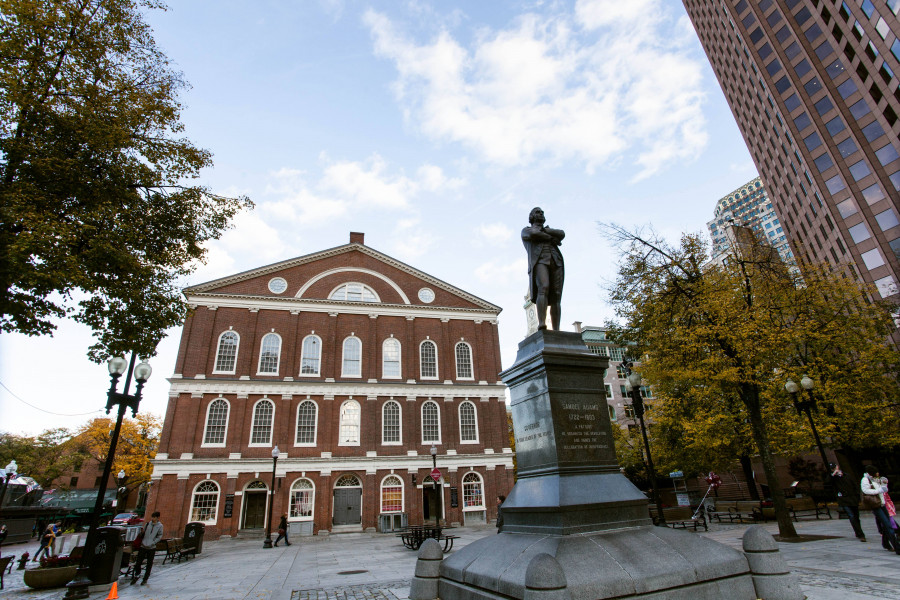
Photo by Alex Lau
26. Faneuil Hall
iv S Market St., Boston
Year completed: 1742
Architect: John Smibert, with a Charles Bulfinch renovation
"Cradle of Liberty," "dwelling house of free speech communication," or "tourist trap"—whatever you lot call it, Faneuil Hall is one of Boston'south most-visited and most-recognizable buildings. Originally congenital in a severely traditional fashion to house meetings and markets for the city of Boston, Charles Bulfinch swooped in around 1806 to double its width, add a flooring, and move the cupola from the eye to its iconic perch at the front.
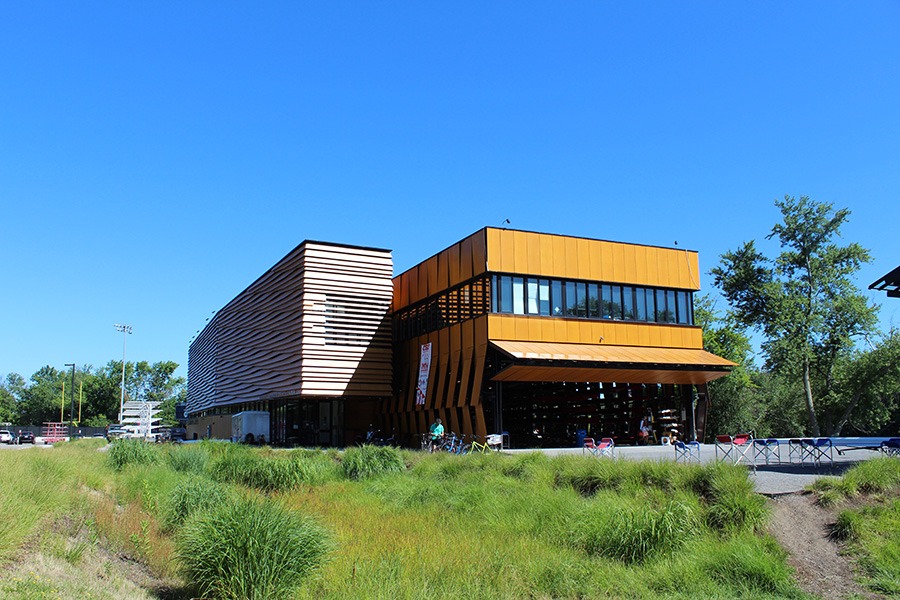
Photo by Ellen Gerst
25. Community Rowing Boathouse
xx Nonantum Rd., Brighton
Year completed: 2008
Architect: Anmahian Winton Architects
The nation's largest public rowing organization has sick digs. The boathouse, i of the few on the Charles not endemic and operated by a college, looks out on the water with huge windows and lets the cakewalk in with woods panels that resemble the river itself.
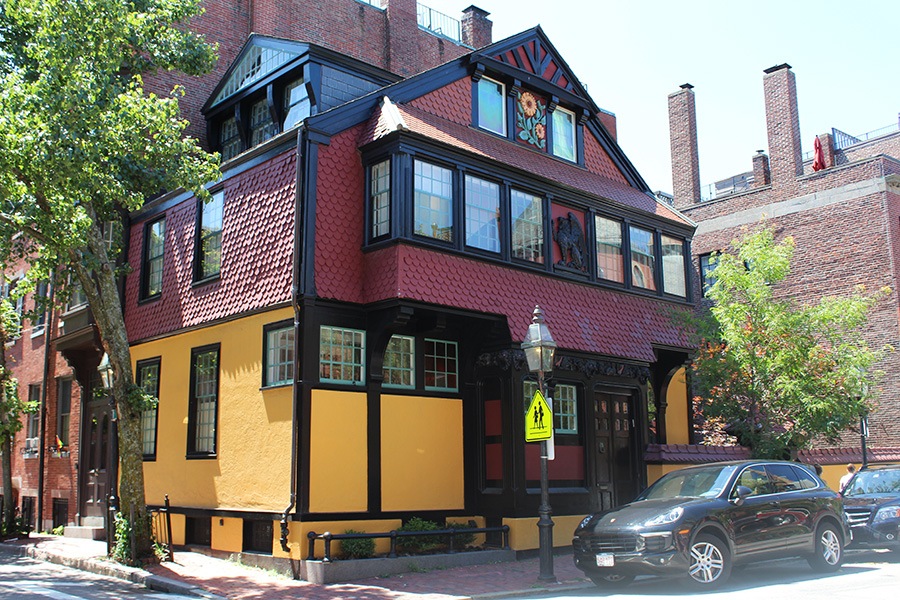
Photo by Ellen Gerst
24. Sunflower Castle
130 Mount Vernon St., Boston
Year completed: 1845
Builder: Clarence Luce, James McNeely, Frank Hill Smith
The Sunflower Castle blooms like a big, bright blossom amongst more traditional Federal and Colonial-manner structures. Though information technology was congenital in 1845, it was architects Clarence Luce and Frank Loma Smith who overhauled the exterior to convert the home into a flowery residence in 1878. Today, the colorful Arts and Crafts abode is hands recognizable nigh the corner of Mount Vernon and Charles Streets, thanks to its petal-filled medallions carved into the walls nether its eaves. The iconic "castle" was famously dwelling house to watercolor artist Gertrude Beals and her hubby, architect Frank Bourne. Beals painted her studio inside the home in a work titled " The Artist's Studio—Sunflower Castle ."

Photo by Ellen Gerst
23. Memorial Hall
45 Quincy St., Cambridge
Year completed: 1877
Architect: William Robert Ware, Henry Van Brunt
To a small child, Memorial Hall looks similar merely some other one of Harvard'due south red brick buildings. Grow a little taller and you lot can capeesh the High Gothic building's stained glass windows and beautifully patterned roof, tiled in alternate blue, tan, and ruddy stripes and triangles. The crown precious stone is the structure's tower, iced in ruddy and blue and consummate with a zig zag design.

Photograph past Alex Lau
22. Cutler Imperial Theatre
219 Tremont St., Boston
Year completed: 1903
Builder: John Galen Howard
Saved from the wrecking brawl in 1983 by Emerson College and subsequently restored past Elkus Manfredi Architects, the Cutler Majestic is, well, regal. From the exterior, arches frame a trio of Tiffany stained-drinking glass windows flanked by fluted Ionic columns. The theater'south splendor is further accentuated by intricate stone carvings of fruit atop each window, surrounding 3 theater masks depicting happiness, sadness, and anger. Inside, the atmosphere is Edenlike, as the ceiling is designed to resemble a heavenly trellis with patches of blue heaven.

Photograph past Alex Lau
21. One-time State House
206 Washington St., Boston
Yr completed: 1713
Builder: Original unknown. Restorations by Isaiah Rogers; George Albert Clough; Goody, Clancy & Assembly
Another brick Georgian building from Colonial times, the Onetime State House doesn't have a fancy aureate hat similar the new one, but information technology has a heck of a history. It was the site of the Boston Massacre and the place where the Declaration of Independence was beginning read, to beginning. Its facade boasts a beautifully busy clock and statues of a lion and a unicorn. A time capsule from 1901 was found inside the lion's head in recent years, so replaced with a new capsule in 2014.
20. South Station
700 Atlantic Ave., Boston
Twelvemonth Completed: 1899
Architect: Shepley, Rutan & Coolidge; Norcross Bros.
Similar a tiered wedding cake, Southward Station is a masterpiece of Neoclassical architectural highlights. The Beaux Arts landmark is one of Boston's grandest gatekeepers and has a regality conforming its role.
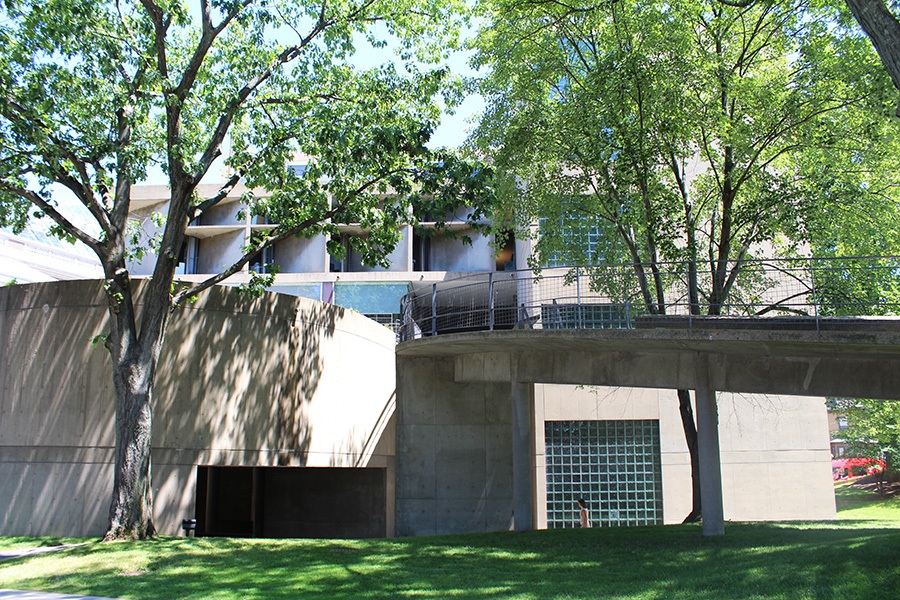
Photo by Ellen Gerst
19. Carpenter Eye for the Visual Arts
24 Quincy St., Cambridge
Year Completed: 1963
Builder: Le Corbusier with Sert, Jackson & Gourley
Behold the only Le Corbusier cosmos in the entire The states. Located on Harvard's campus in Cambridge, this Modernist edifice serves as the university's art center. Every side of this funky structure reveals a unique perspective. Y'all're jump to appreciate at to the lowest degree one.
xviii. J ohn F. Kennedy Library & Museum
Columbia Point, Boston
Year completed: 1979
Architect: I.M. Pei, I.M. Pei & Partners
The John F. Kennedy Library & Museum revels in simplicity. Finished in 1979 on breathtaking Columba Point (later considering viii different sites) the I.M. Pei creation overlooks the ocean. A brilliant, white nine-story pyramid anchors the structure, connecting to a two-story cylinder-shaped building with help from a parallelogram of gray glass. According to the Boston Society of Architects' AIA Guide to Boston , the drinking glass housing the 110-foot-loftier Presidential Pavilion is an architectural statement to its importance.

Photo by Simone Migliori
17. Horticultural Hall
300 Massachusetts Ave., Boston
Year completed: 1901
Architect: Edmund March Wheelwright
When Horticultural Hall opened in 1901, its first residents were some of the city's brightest—and best-smelling: azaleas, geraniums, trumpet lilies, palms, wisteria, and hundreds of orchids dazzled visitors. But today, instead of flowers, the English language Renaissance-fashion edifice'southward atrium is dwelling to the offices of this very publication. Built as the 3rd Horticultural Hall in Boston (the other two take since been demolished), the structure flaunts huge pilasters, wreaths, and stone garlands of fruit and plants. It was designed past Edmund March Wheelwright, an influential builder and bang-up-uncle of builder Harry Cobb, who also designed the Longfellow Span, Harvard Lampoon Building, and the Massachusetts Historical Guild, among other Boston buildings.
16. MIT Chapel
48 Massachusetts Ave., Cambridge
Year completed: 1955
Architect: Eero Saarinen
One of just a few Saarinen buildings in New England, the MIT Chapel is a midcentury wonder. From the outside, its curving brick walls make a argument on campus. Inside, still, they accept on a whole new meaning. A circular skylight carved out of the ceiling provides the just light source for the not-denominational center for worship. A hanging sculpture by Harry Bertoia suspends in this light, cascading all the fashion down to the floor. With the cylindrical walls as a backdrop, the space emanates an otherwordly sense of calm.
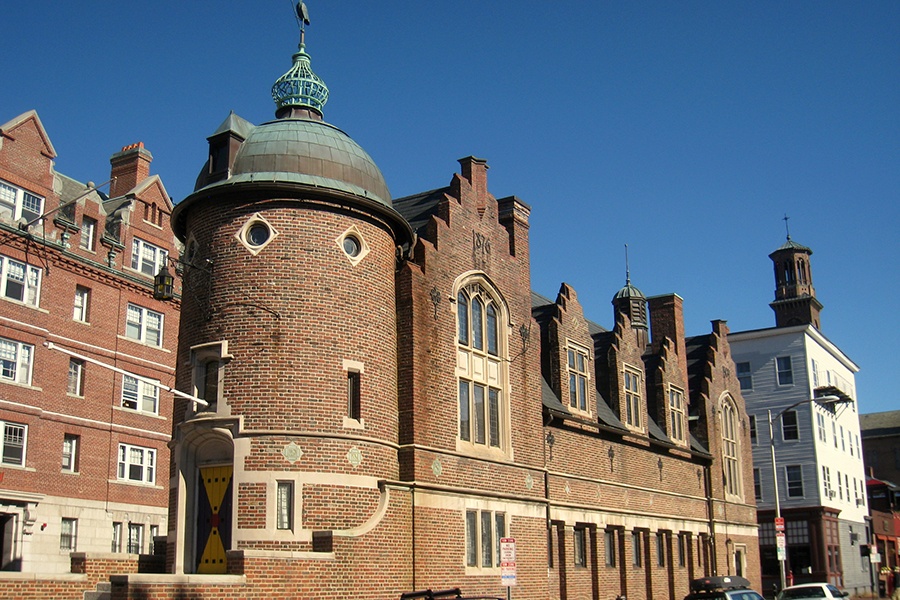
Photo via Wikimedia/Creative Eatables
15. Harvard Lampoon Edifice
44 Bow St., Cambridge
Yr completed: 1909
Builder: Edmund March Wheelwright
Some say it looks stupid, but the Lampoon Castle'due south airheaded brick facade, built to resemble a face up with a lid, jibes perfectly with the world'south second-longest continually published humor mag's eclectic vibe. Its hat—sad, its roof—is topped with an ibis statue, at least when it's not being stolen by the Crimson staff.
xiv. Quincy Market
4 S Marketplace St., Boston
Twelvemonth Completed: 1826
Architect: Alexander Parris
Most become for the food or the spectacle, and this building is rarely gratis of the hordes. Simply accept a breather next fourth dimension to appreciate Quincy Market's grand old Greek Revival columns and the imperial cornices that accept disregarded the decorated streets since 1742 .
13. Sometime South Church
645 Boylston St., Boston
Yr completed: 1873
Builder: Charles Amos Cummings, Willard T. Sears
The Old South Church is truly a part of Boston—it'southward literally congenital out of the bedrock that lies underneath Roxbury. It's a proud member of the High Victorian Gothic architectural family unit, with ornate wrought iron and red and greyness stonework. Yes, information technology's got that super-visible campanile, but the One-time S Church as well has a "lantern" (or a copper-covered cupola) on top.
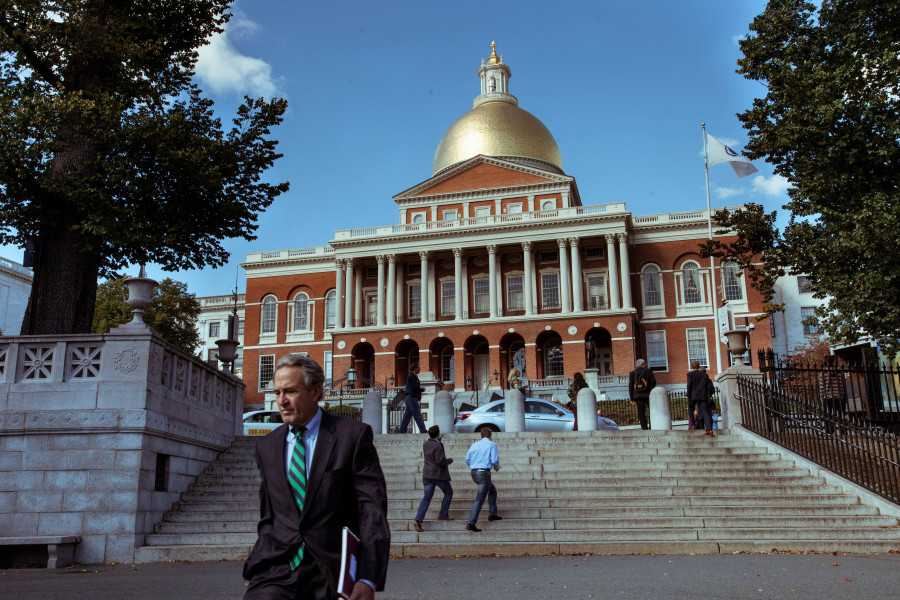
Photograph by Alex Lau
12. Land Firm
24 Beacon St., Boston
Year Completed: 1798
Builder: Charles Bulfinch
The State Firm is renowned as a landmark of Federal compages, and its trim exterior certainly exudes a business-like regality conforming a government building. The architect, Charles Bulfinch, was a true Bostonian through-and-through, and the clear choice for the Country Firm's designer. Bulfinch was born and raised in the city, and though he worked on several projects in the development of the U.Southward. Capitol, he never strayed too far from Boston. The copper for the State House'south original dome was supplied by the company of some other of import Bostonian, Paul Revere. Aye, that Revere.
eleven. Trinity Church
206 Clarendon Street, Boston
Twelvemonth Completed: 1877
Builder: Henry Hobson Richardson
Trinity Church is a Gothic interlude to the commercial Newbury Street neighborhood. With its cast of stone-faced gargoyles, the impressive edifice looms over passers-by like some huge medieval chess piece. Its auditorium was designed to reflect the emerging democratic spirit of the tardily 19th century. The overall mode was dubbed Richardsonian Romanesque after the architect.
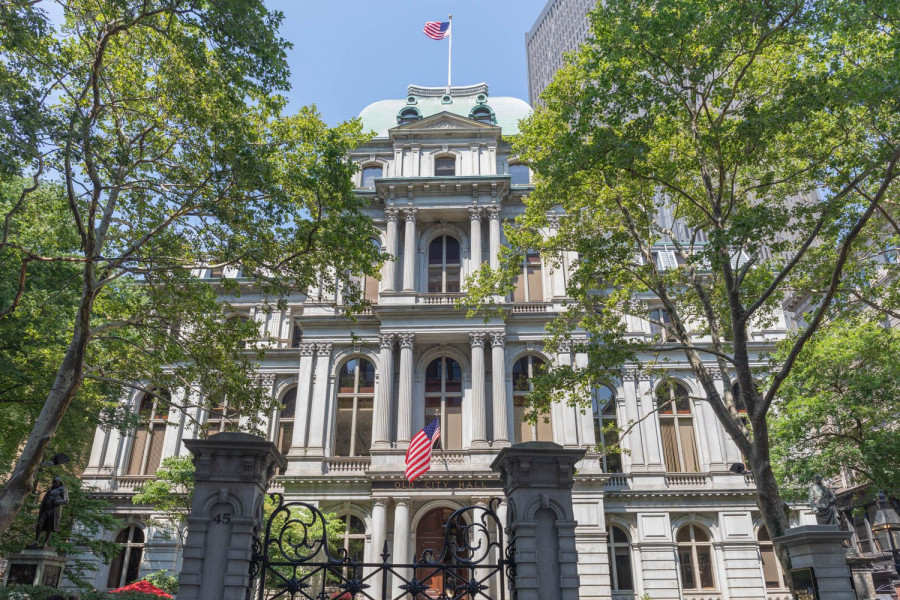
Photograph by Eric Clark
x. Quondam City Hall
45 School St., Boston
Year completed: 1865
Architect: Arthur Gilman and Gridley James Fox Bryant
Despite its name today, Erstwhile Metropolis Hall was a refreshingly new manner of building upon completion in 1865. Its architects, Arthur Gilman and Gridley James Play tricks Bryant, drafted a pattern never before seen in Boston, borrowing from the new addition to the Louvre in Paris to build ane of the get-go French 2nd Empire structures in the United States. A protruding cardinal pavilion dominates the 80,000-foursquare-human foot building, topped past a sloping mansard roof—a hallmark of French Second Empire blueprint. At 1 point, the Boston Redevelopment Authority talked of demolishing Old City Hall, simply an early on example of adaptive reuse saved the place. At present it's dwelling house to a Ruth'due south Chris Steakhouse and several offices. Better than a pile of rubble, eh?
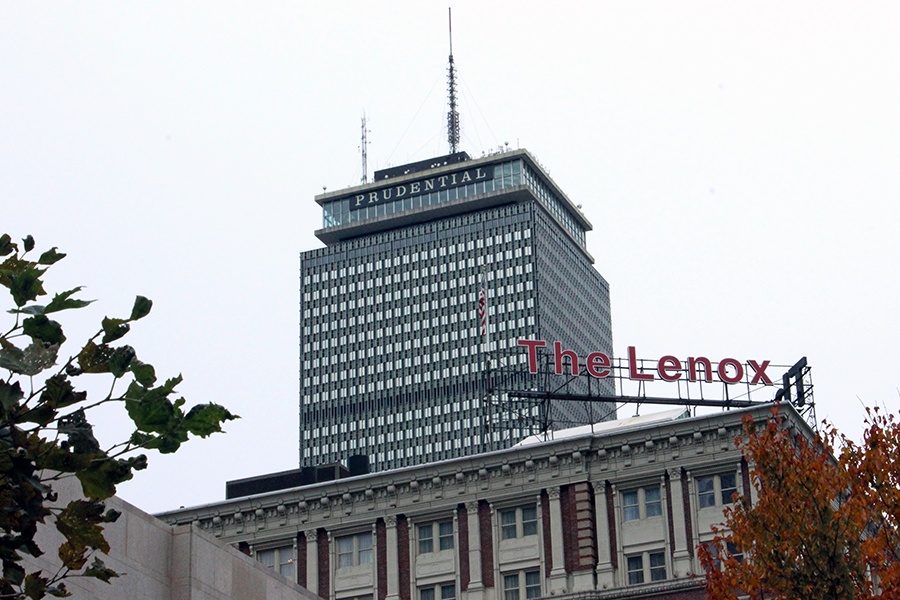
Photo past Olga Khvan
9. Prudential Center
800 Boylston St., Boston
Year completed: 1964
Architect: The Luckman Partnership
When the Pru pierced Boston's curt skyline in 1964, it towered over everything. Today, near Bostonians tin't picture the city without it—postcards, t-shirts, and Instagrams aren't complete without a likeness of the International-style structure. The Hub's favorite skyscraper, which is crowned past the Top of the Hub restaurant, soars 749 feet high, and is the 2d-tallest building within city limits (for now, at least).

Photo by Meredith Foley
eight. Boston Public Library
700 Boylston St., Boston
Year completed: 1895
Architect: McKim, Mead, and White
The BPL is a combination of two stunning structures: the Beaux Arts McKim Building and Brutalist Johnson Building. The McKim has ever had impressive curb appeal, from its iron scones to its arching statuary doors. The Johnson, added by architect Philip Johnson in 1972, wasn't e'er so fortunate. Just in 2016, William Rawn Associates finished an overhaul to the addition , opening it up to the street and letting arable light stream into the land'southward first public library.
7. Custom House Tower
3 McKinley Foursquare, Boston
Yr completed: 1847, tower added in 1915
Architect: Ammi Burnham Immature, tower added by Peabody & Stearns
For Boston'south first skyscraper, you'd think the city would accept scraped enough money together for a functional clock. This Neoclassical tower, smack dab in the center of Boston, had a faulty clock for most of the 20th century due to a motor that was likewise small to ability its copper-plated California redwood hands. The erstwhile customs house is at present a Marriott timeshare hotel, nevertheless it's notwithstanding decked out with Quincy granite columns and a dome carved from Vermont white marble.
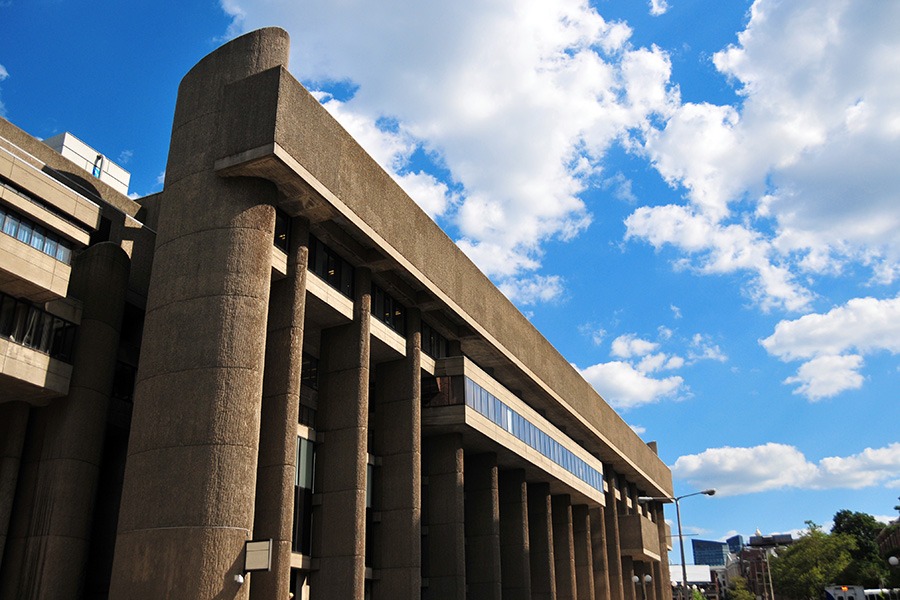
Photo via iStock
6. Erich Lindemann Mental Health Center
25 Staniford St., Boston
Year completed: 1971
Builder: Paul Rudolph
The Erich Lindemann Mental Health Center is a hulking, overlooked mass of physical that's part of an incomplete building complex. It'due south also a stunning achievement of one of the 20th century's virtually renowned Modernist architects. Designed by Paul Rudolph in 1962 and completed in 1971, the Brutalist creation is a decidedly imposing presence only a few blocks from Urban center Hall. Dramatic concrete projections heighten its grandeur, while night shadows are cast by sunshades. Perhaps its most distinctive feature is its rippling walls, which workers finished by manus, showtime casting the physical in ribbed wooden molds before using bush hammers to flake abroad at the aggregate. A balance of course and function, the texture masks large swaths of the exterior from the discoloration that comes from weathering.

Photo by Eric Clark
5. Berkeley Building
414-426 Boylston St., Boston
Twelvemonth completed: 1905
Architect: Stephen Codman and Abiding Désiré Despradelle
It's true that at that place are two structures in the city referred to every bit the Berkeley Edifice, but this one, (equally opposed to what'south known as the Old John Hancock Building) is the original. The six-story building is one of the most extraordinary examples of Beaux Arts architecture in Boston. It'south too one of the most notable commercial buildings of the early 20th century, co-ordinate to the Boston Landmarks Commission. That's thanks in function to its defining feature: a terra cotta outside. The material has been preserved over the years, and the facade'southward sea motif is still intact. On your adjacent walk by, take a 2nd to appreciate the ornate grill work that tops the building, then await for the fish, seaweed, and bounding main shell sculptures adorning the exterior.

Photograph by Eric Clark
4. Christian Science Centre Assistants Building
177 Huntington Ave., Boston
Year completed: 1972
Architect: Araldo Cossutta, I.M. Pei & Partners
The outside of 177 Huntington Ave. is directly out of 1972 (in a good style) thanks to its Brutalist grid design that refuses to be overlooked. But its recently reimagined interior, with a "media wall" projecting low-cal patterns from the before long-to-exist-finished reflecting pool outside, makes the former Christian Science Eye Administration Building feel new again.

Photo by Samantha Carey
three. 200 Clarendon
120 St. James Ave., Boston
Twelvemonth completed: 1976
Architect: Henry Cobb, I.Thousand. Pei & Partners
In its early days, the Hancock Tower (now known as 200 Clarendon) faced quite a few challenges. Most notably, during construction, windows bankrupt and crashed to the street on windy days. Simply that'southward all in the past for the iconic tower, which gleams and glimmers in all shades of blue and grey against a celebrated brick properties. As the tallest building in New England, the 790-foot-autumn Hancock is also one of its virtually beautiful, thanks to its all-glass exterior envelope. Information technology was designed by renowned architect Harry Cobb , who also designed the tower that will soon take the tallest title: One Dalton.
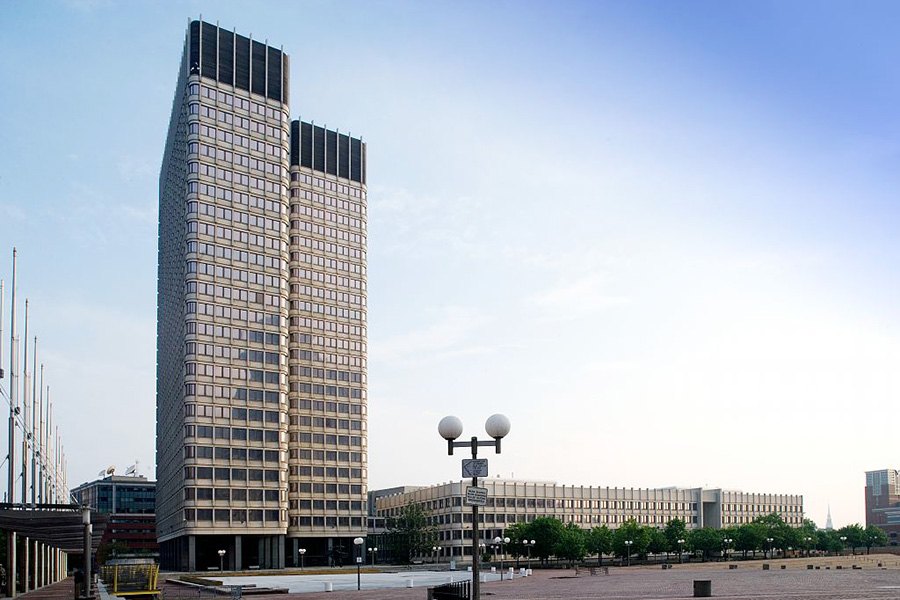
Photo via Wikimedia/Artistic Eatables
2. JFK Federal Edifice
15 Sudbury St., Boston
Year completed: 1966
Builder: Walter Gropius and Norman C. Fletcher of The Architects Collaborative with Samuel Glaser
Prior to construction of the John F. Kennedy Federal Building, information technology was rare for the federal government to fully cover modernistic architecture. And that'south what makes the JFK edifice so remarkable. Designed by Walter Gropius, the German founder of the Bauhaus schoolhouse, the edifice is a true modernistic marvel. He worked under the business firm The Architects Collaborative (TAC) along with his assistant, Samuel Glaser, to craft two 26-story towers, anchored past a much lower four-story building.
Gropius' Bauhaus ideals, which laid the footing for modern and International design, can be easily glimpsed in the JFK building. Its steel, glass, and concrete towers are sleek, refined, and minimally ornamented. The staggered towers make a statement of simplified blueprint, rather than taking cues from their environs.
i. City Hall
one City Hall Sq., Boston
Yr completed: 1968
Architect: Michael McKinnell, Gerhard Kallmann, Edward Knowles
Ah, City Hall. If it'due south possible to be the nearly-hated and most-loved building in Boston at the aforementioned time, so this ane takes the prize. Though it'due south been ranked one of the ugliest structures in the world, Metropolis Hall is, in fact, not ugly. It'due south brutal and it's beautiful. A reigning example of Brutalist architecture, Boston's concrete-covered nerve middle was the winning model of a 1962 design competition, and was built after Scollay Foursquare was razed to brand fashion for Government Center. The building was finished in 1968, and has been delighting (and horrifying) passersby with its honeycomb-like facade always since.
The Boston Abode squad has curated a listing of the best home design and home remodeling professionals in Boston, including architecture firms, dwelling house builders and contractors, edifice supplies, custom woodworking, and more. Go the aid you need with FindIt/Boston'southward guide to home renovation pros.
Source: https://www.bostonmagazine.com/property/2018/07/25/100-best-boston-buildings/

0 Response to "Edwin J Thomas Performing Arts Hall Architecture Design Brutalism"
Post a Comment